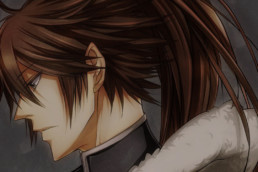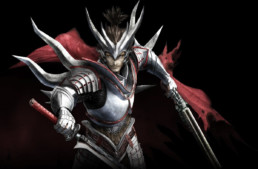Japan History: Date Masamune
Date Masamune
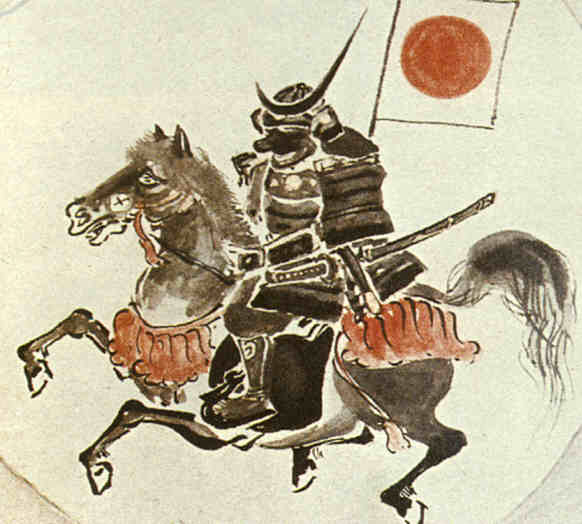
Photo Credits: samurai-archives.com
Date Masamune (伊達 政宗, September 5, 1567 – June 27, 1636) was a regional ruler of Japan's Azuchi–Momoyama period (last part of the Sengoku period) through early Edo period. Heir to a long line of powerful daimyōs in the Tōhoku region, he went on to found the modern-day city of Sendai. An outstanding tactician, he was made all the more iconic for his missing eye, as Masamune was often called dokuganryū (独眼竜), or the "One-Eyed Dragon of Ōshu".
Early life
Date Masamune was born as Bontemaru (梵天丸) in Yonezawa Castle (in modern Yamagata Prefecture). He was the eldest son of Date Terumune, a lord of the Rikuzen area of Mutsu, and Yoshihime, a daughter of Mogami Yoshimori, daimyo of the Dewa province. He recieved the name Tojirou (藤次郎) Masamune in 1578, and the following year he married Megohime, the daughter of Tamura Kiyoaki, lord of Miharu castle, in Mutsu Province. At the age of 14, in 1581, Masamune led his first campaign, helping his father fight the Sōma family. In 1584, at the age of 17, Masamune succeeded his father, Terumune, who chose to retire from his position as daimyō.
Masamune's army was recognized by its black armor and golden headgear. Masamune himself is known for a few things that made him stand out from other daimyōs of the time. In particular, his famous crescent-moon-bearing helmet won him a fearsome reputation.
As a child, smallpox robbed him of sight in his right eye, though it is unclear exactly how he lost the organ entirely. Various theories behind the eye's condition exist. Some sources say he plucked out the eye himself when a senior member of the clan pointed out that an enemy could grab it in a fight. Others say that he had his trusted retainer Katakura Kojūrō gouge out the eye for him, and this, together with his fearsome temperament, made him the 'One-Eyed Dragon' of Ōshu.
Military campaign
The Date clan had built alliances with neighboring clans through marriages over previous generations, but local disputes remained commonplace. Shortly after Masamune's succession in 1584, a Date retainer named Ōuchi Sadatsuna defected to the Ashina clan of the Aizu region. Masamune declared war on Ōuchi and the Ashina for this betrayal, and started a campaign to hunt down Sadatsuna. Many clans, even formerly amicable allies, fell. In the winter of 1585, one of these allies, Hatakeyama Yoshitsugu, felt defeat was approaching and chose to surrender to the Date. Masamune agreed to accept the surrender, but on the heavy condition that the Hatakeyama give up most of their territory to the Date. This resulted in Yoshitsugu kidnapping Masamune's father, Terumune, during their meeting in Miyamori Castle, where Terumune was staying at during the time. The incident ended with the death of Terumune, while fleeing Hatakeyama men clashed with the Date troops near the Abukuma river.
A general war ensued between the Date and Hatakeyama, the latter drawing on support from the Satake, Ashina, Soma, and other local clans. The allies marched to within a half-mile of Masamune's Motomiya-jo, assembling some 30,000 troops for the attack. Masamune, having only 7,000 warriors, prepared a defensive strategy, relying on the series of forts that guarded the approaches to Motomiya. The fighting began on the 17th of November, and did not progress well for the Date. Three of his valuable forts were taken, and one of his chief retainers, Moniwa Yoshinao, was killed in a duel with an opposing commander. The attackers pressed towards the Seto River, which was the last obstacle between them and Motomiya. Date attempted to turn them back at the Hitadori Bridge, but was driven back. Masamune brought his remaining forces within Motomiya's walls, and prepared for what would surely be a gallant but futile last stand. But the next morning,the main enemy contingent picked up and marched away. These were Satake Yoshishige's men. Their lord had received word that in his absence the Satomi had attacked his lands in Hitachi. Apparently this left the allies with fewer men than they believed possible to bring down Motomiya, for they too retreated by the end of the day. This brush with utter defeat was likely a factor in turning Masamune into the renowned general he would one day be known as. In the wake of the battle, peace was struck with the Hatakeyama and Soma, although this was to prove short-lived.
In 1589, Date defeated the Soma, and bribed an important Ashina retainer, Inawashiro Morikuni, over to his side. He then assembled a powerful force and marched straight for the Ashina's headquarters at Kurokawa. The Date and Ashina forces met at Suriagehara on 5 June when Masamune's forces overcame the faltering Ashina ranks, breaking them. Unfortunately for the Ashina, Date men had destroyed their avenue of escape, a bridge over the Nitsubashi River, and those who did not drown attempting to swim to safety were mercilessly put to the sword.
By the battle's end, Masamune could count something like 2,300 enemy heads in one of the more bloody and decisive battles of the Sengoku period. Masamune then proceeded to make the rich Aizu domain his base of operations.
However, this would be Date Masamune's last expansionist adventure.
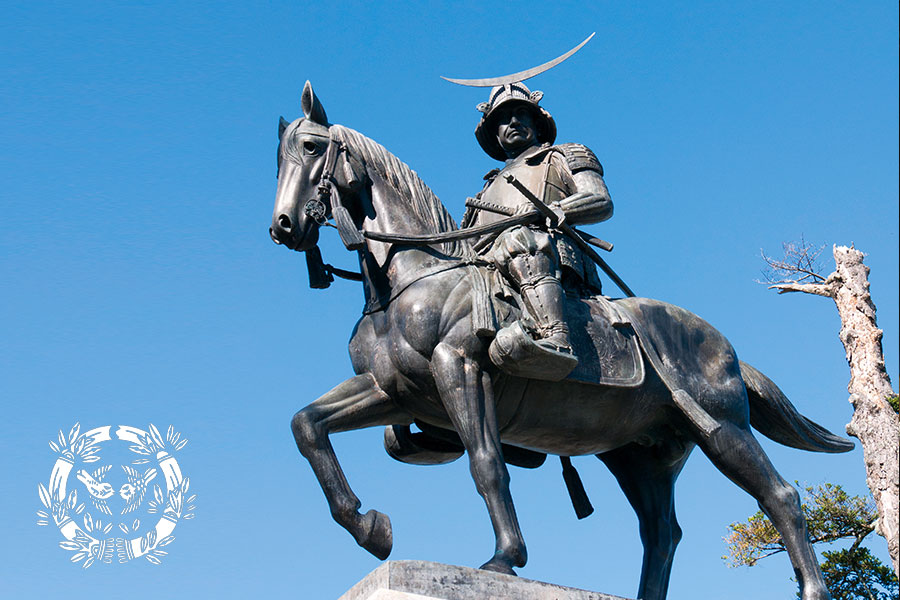
Photo credits: wattention.com
Statua di Date Masamune nella città di Sendai sulle rovine del Castello di Sendai,
Service under Toyotomi Hideyoshi and Tokugawa Ieyasu
In 1590, Toyotomi Hideyoshi seized Odawara Castle and compelled the Tōhoku-region daimyōs to participate in the campaign. Although Masamune refused Hideyoshi's demands at first, he had no real choice in the matter since Hideyoshi was the virtual ruler of Japan. However, the delay infuriated Hideyoshi. Expecting to be executed, Masamune, wore his finest clothes showing no fear in facing his angry overlord. But Hideyoshi spared his life, saying that "He could be of some use".
Following the conclusion of the siege, Masamune was forced to relinquish his newly won holdings in Aizu and was give Iwatesawa and the surrounding lands. Lands that would have earned him less, though. Masamune moved there in 1591, rebuilt the castle renaming it Iwadeyama, and encouraged the growth of a town at its base. Masamune stayed at Iwadeyama for 13 years and turned the region into a major political and economic center.
He and his men served with distinction in the Korean invasions under Hideyoshi and, after Hideyoshi's death, he began to support Tokugawa Ieyasu, apparently at the advice of Katakura Kojūrō. For this reason Masamune was awarded with the lordship of the huge and profitable Sendai Domain, which made Masamune one of Japan's most powerful daimyōs. Tokugawa had promised Masamune a one-million koku domain but, even after substantial improvements were made, the land only produced 640,000 koku. And most of the earnings were used to feed the Edo region. In 1604, Masamune, accompanied by 52,000 vassals and their families, moved to what was then the small fishing village of Sendai. He left his fourth son, Date Muneyasu, to rule Iwadeyama.
Masamune would turn Sendai into a large and prosperous city.
Although Masamune was a patron of the arts and sympathized with foreign causes, he was also an aggressive and ambitious daimyō. When he first took over the Date clan, he suffered a few major defeats from powerful and influential clans such as the Ashina. These defeats were arguably caused by recklessness on Masamune's part.
Being a major power in northern Japan, Masamune was naturally viewed with suspicion. Toyotomi Hideyoshi had reduced the size of his land after his tardiness in coming to the Siege of Odawara against Hōjō Ujimasa. Later, Tokugawa Ieyasu increased the size of his lands again, but was constantly suspicious of Masamune and his policies.
Although Tokugawa Ieyasu and other Date allies were always suspicious of him, Date Masamune for the most part served both Toyotomi and Tokugawa loyally. He took part in Hideyoshi's campaigns in Korea, and in the Osaka campaigns too. When Tokugawa Ieyasu was on his deathbed, Masamune visited him and read him a piece of Zen poetry.
Masamune was highly respected for his ethics, and a still-quoted aphorism is, "Rectitude carried to excess hardens into stiffness; benevolence indulged beyond measure sinks into weakness."
Patron of culture and Christianity
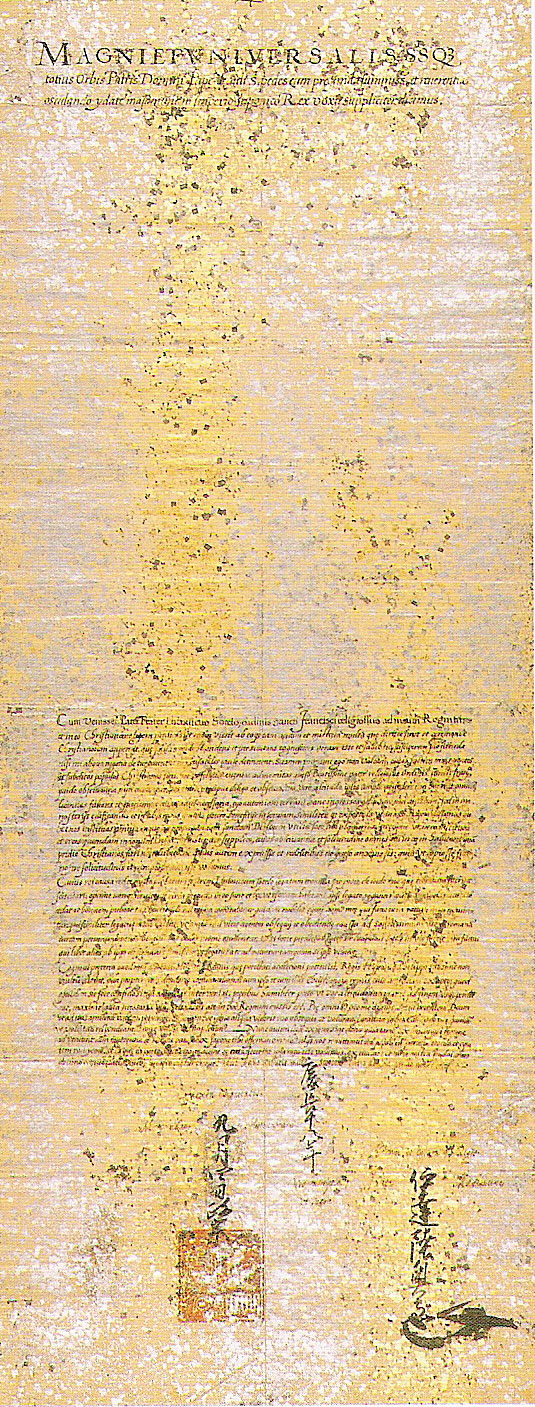
Photo Credits: wikimedia.org
Una lettera scritta da Masamune al Papa Paolo V
Masamune expanded trade in the otherwise remote, backwater Tōhoku region. Although initially faced with attacks by hostile clans, he managed to overcome them after a few defeats. In the end, he eventually ruled one of the largest fiefdoms of the later Tokugawa shogunate. He built many palaces and worked on many projects to beautify the region. For 270 years, Tōhoku remained a place of tourism, trade and prosperity. Matsushima, for instance, a series of tiny islands, was praised for its beauty and serenity by the wandering haiku poet Matsuo Bashō.
Other than being known to have encourage foreigners to come to his land, Masamune also showed sympathy for Christian missionaries and traders in Japan. In addition to allowing them to come and preach in his province, he also released the prisoner and missionary Padre Sotelo from the hands of Tokugawa Ieyasu. Date Masamune allowed Sotelo as well as other missionaries to practice their religion and win converts in Tōhoku.
Moreover, he funded and promoted an expedition to establish diplomatic relations with the Pope in Rome, even though he was likely motivated at least in part by a desire for foreign technology. In this, he was similar to other lords, such as Oda Nobunaga. For the expedition he ordered the building of the exploration ship Date Maru or San Juan Bautista, using European ship-building techniques. He sent one of his retainers, Hasekura Tsunenaga, Sotelo, and an embassy numbering 180 people on a successful voyage that included places as the Philippines, Mexico, Spain and Rome, of course. Previously, Japanese lords had never funded this sort of venture, so it was probably the first of such voyages. At least five members of the expedition stayed in Coria, Spain, to avoid the persecution of Christians in Japan. 600 of their descendants, with the surname Japón (Japan), are now living in Spain.
When the Tokugawa government banned Christianity, Masamune had to obey the law reversing his position, and though disliking it, let Ieyasu persecute Christians in his domain. However, some sources suggest that Masamune's eldest daughter, Irohahime, was a Christian.
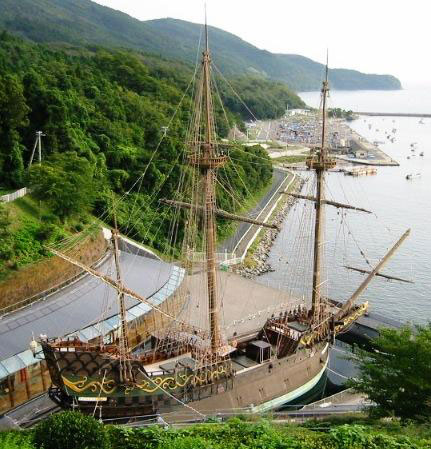
Photo credits: it.wikipedia.org
Replica del galeone Date Maru, o San Juan Bautista, a Ishinomaki, Giappone
Masamune had 16 children, two of whom were illegitimate, with his wife and seven concubines. He died in 1636 at the age of 69. In October 1974, Date Masamune’s grave was opened. Inside, along with his remains, archaeologists discovered his tachi sword, a letter box with a paulownia crest, and his armor. From the study of those remains, they determined Masamune to have stood 159.4cm tall, and having type B blood.
As legendary warrior and leader, Masamune is the character of various Japanese dramas. He was also played by the famous Ken Watanabe in the popular 1987 NHK series Dokuganryū Masamune.
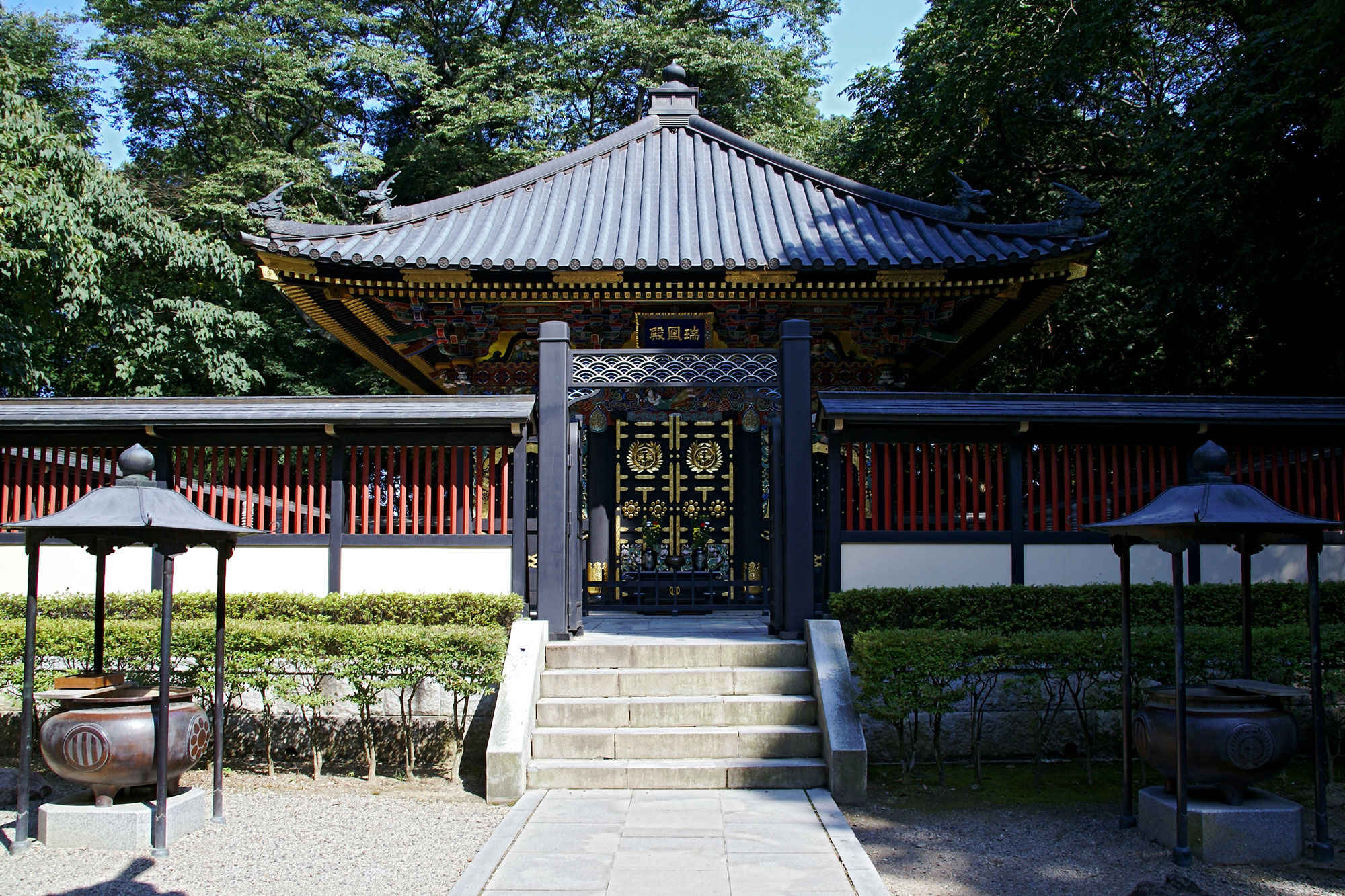
Photo credits: wikimedia.org
La tomba di Masamune al mausoleo di Zuihōden
Japan History: Ishikawa Goemon
Ishikawa Goemon

Photo credits: data.ukiyo-e.org
Ishikawa Goemon (石川 五右衛門, 1558 – 8 Ottobre, 1594) è stato un fuorilegge Giapponese semi leggendario che rubava oggetti di valore ai ricchi per darli ai poveri. Proprio per questa sua caratteristica viene a volte definito il Robin Hood del Giappone. Esistono molte storie che lo vedono protagonista e che lo descrivono come un eroe popolare che si batte contro i potenti per i più deboli. L’autenticità di queste storie tuttavia non è sempre certa.
La sua prima apparizione negli annali storici si ritrova nella biografia di Toyotomi Hideyoshi del 1642 che lo descriveva semplicemente come un ladro.
Ci sono varie versioni della vita di Ishikawa Goemon. Secondo una di queste, egli nacque come Sanada Kuranoshin nel 1558 da una famiglia di samurai al servizio del clan Miyoshi della provincia di Iga. Nel 1573, quando suo padre, presumibilmente Ishikawa Akashi, fu assassinato dagli uomini dello shogunato Ashikaga, il quindicenne Sanada giurò vendetta. Cominciò quindi ad allenarsi nelle arti del ninjutsu a Iga sotto Momochi Sandayu. Allievo abilissimo ma di temperamento irruento, fu costretto a scappare quando il suo maestro scoprì la relazione di Sanada con una delle sue amanti.
Altre fonti gli danno il nome di Gorokizu, la cui provenienza viene individuata nella Provincia di Kawachi e non era un nunekin (ninja fuggitivo). Si era poi spostato nella regione del Kansai dove formò e guidò una banda di ladri e banditi come Ishikawa Goemon. Con questa banda rubava ai ricchi signori feudali, mercanti e clericali, condividendo poi il bottino con i poveri.
Secondo un’altra versione, che gli ha anche attribuito un attentato a Oda Nobunaga, sembra sia stato obbligato a diventare un ladro quando la rete organizzativa dei ninja fu distrutta.
Ciò che è certo è che Ishikawa Gomen divenne presto un personaggio popolare e apprezzato dal popolo, e non mancano gli aneddoti sulle sue avventure. Si dice che una volta, entrato in una stanza per compiere un furto, venne distratto dal sorriso di un bambino. Ishikawa cominciò a giocare con lui perdendo così il momento per mettere a segno il colpo. Un’altra storia riguarda il suo tentativo di assassinare il grande generale Oda Nobunaga. Una volta entrato nell’edificio di Oda, si nascose nell’attico proprio sopra la camera da letto del generale. Quando questi si fu coricato, Ishikawa praticò un buco sul soffitto proprio in corrispondenza della testa di Oda. Dal buco calò un tubicino tenendolo sospeso sopra la bocca del daimyo, tramite il quale fece passare un potente veleno. Ma il sonno di Oda Nobunaga era leggero e, svegliatosi, riuscì a sventare in tempo l’attentato.
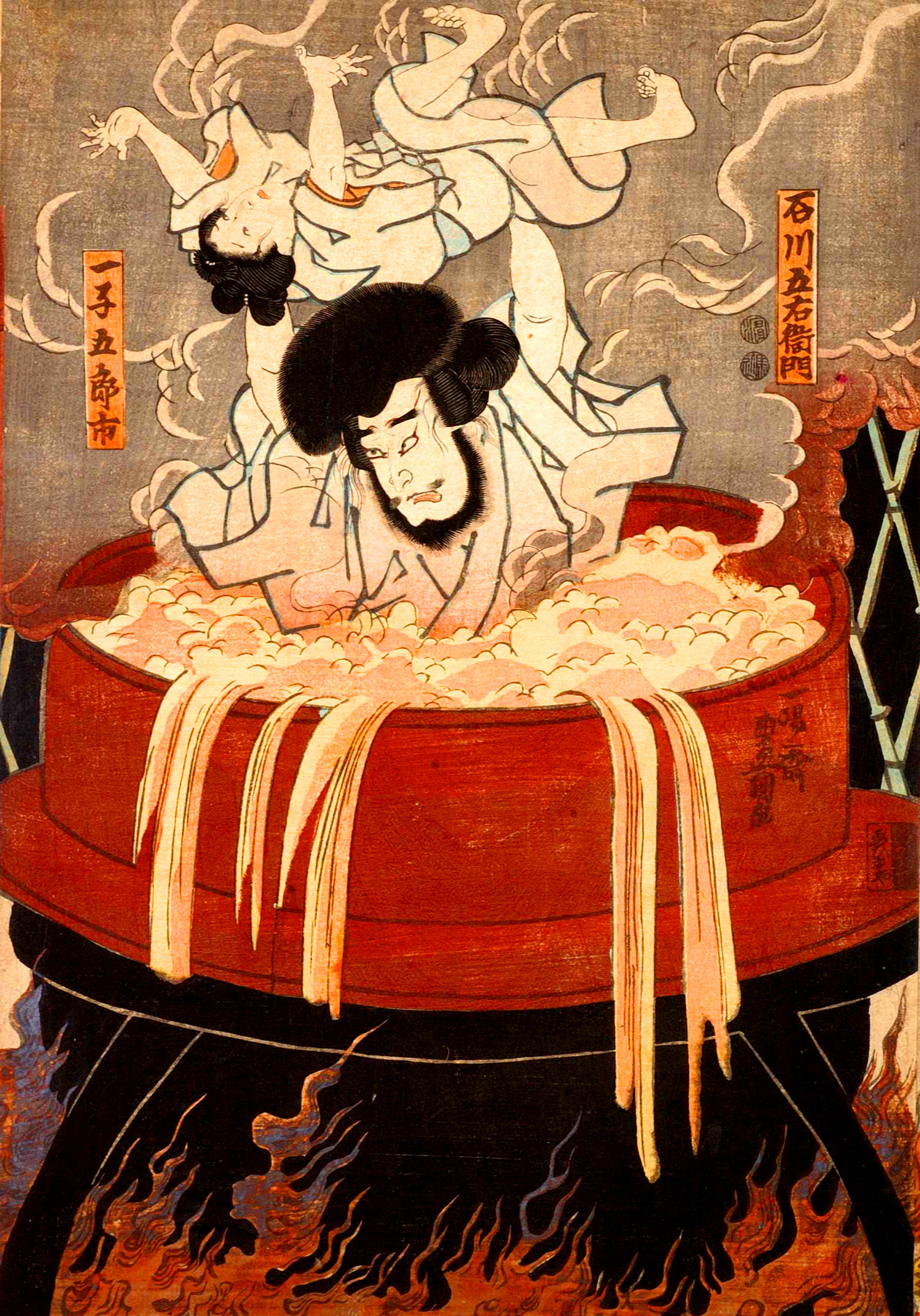
Photo credits: wikipedia.org
Versioni molto conflittuali riguardano anche la sua pubblica esecuzione nell’olio bollente davanti al cancello del tempio Buddhista Nanzen-ji a Kyoto.
Secondo una prima versione, alcuni compagni di scorribande di Goemon furono catturati e costretti a confessare il nome del loro capo.
Una seconda versione afferma invece che Goemon provò ad assassinare Toyotomi Hideyoshi. Alcuni dicono che lo fece per vendicare la morte di sua moglie Otaki e la cattura di suo figlio Gobei, altri perchè lo shogun era ritenuto un despota. Entrato nella camera di Hideyoshi, nel castello di Fushimi, fu però scoperto dalle guardie perché urtò un tavolo facendo cadere una campanella. A volte si parla invece di un bruciatore di incenso magico capace di emettere un suono di richiamo. Fu quindi catturato e condannato a morire, gettato vivo nell’olio bollente in un calderone di ferro, insieme al suo figlio più giovane.
Ma se Goemon incontrò così la sua fine, le storie divergono sul destino del figlioletto. In alcune, Goemon riuscì a salvarlo tenendolo in alto sopra la testa, e il figlio fu poi perdonato. In altre invece, si dice che il padre all’inizio provò a salvare il figlio tenendolo sopra la testa ma, resosi conto della futilità del suo gesto, lo spinse sul fondo del calderone per ucciderlo il prima possibile. Rimase poi con il corpo del bambino sollevato in alto in segno di scherno verso i suoi nemici, fino alla morte per il dolore e le ferite.
Anche la data della sua morte è incerta, alcuni dicono che avvenne in estate, mentre altri la datano l’8 Ottobre, quindi in autunno. Prima di morire, Goemon lasciò un poema d’addio nel quale diceva che qualunque cosa fosse successa, al mondo ci sarebbero sempre stati dei ladri.
Una pietra tombale dedicata a lui può essere visitata ancora oggi nel Tempio Daiunin a Kyoto, mentre le tradizionali vasche verticali giapponesi, solitamente di ferro o legno, prendono ancora oggi il nome di goemonburo (Vasca di Goemon)
Teatro Kabuki e Cultura Popolare
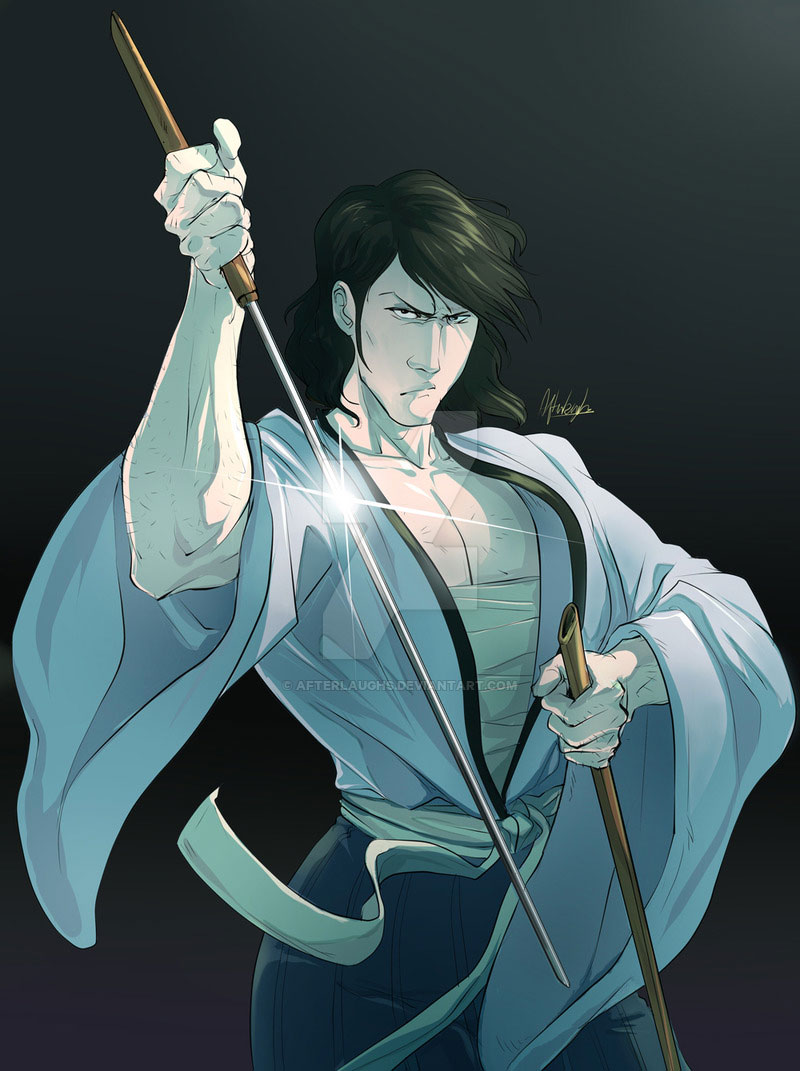
Photo credits: img00.deviantart.net
Ishikawa Goemon è il soggetto di molte rappresentazioni teatrali kabuki. Quella che ancora oggi viene messa in scena è Kinmon Gosan no Kiri (Il Portale d’Oro e lo Stemma di Paulonia). Consiste in cinque atti scritti da Namiki Gohei nel 1778, di cui il più famoso è quello intitolato Sanmon Gosan no Kiri (Il Portale Sanmon e lo Stemma di Paulonia). In questo atto Goemon è visto seduto in cima al portale Sanmon del tempio Nanzen-ji. Sta fumando una pipa d’argento molto grande chiamata kiseru ed esclama “La vista primaverile merita un migliaio di pezzi d’oro, o così dicono, ma è troppo poco, troppo poco. Agli occhi di Goemon ne vale diecimila!” Goemon presto capisce che suo padre, un cinese chiamato So Sokei, era stato ucciso da Mashiba Hisayoshi e comincia a preparare la sua vendetta.
Il suo personaggio appare anche nel famoso racconto Quarantasette Ronin, messo in scena per la prima volta nel 1778. Nel 1992 invece, Goemon appare nella serie kabuki di alcuni francobolli postali Giapponesi.
Nella cultura popolare moderna ci sono in generale due modi in cui Goemon viene rappresentato: un giovane, scaltro ninja, o un potente bandito Giapponese.
Goemon è il personaggio principale della serie di video games Konami Ganbare Goemon dalla quale è stata tratta una serie televisiva. È anche il personaggio principale dei romanzi Shinobi no Mono e della serie di film ad essi ispirati, interpretati da Ichikawa Raizō VIII nel ruolo di Goemon. Nel terzo film, Shin Shinobi no Mono, conosciuto in inglese come Goemon Will Never Die, il protagonista sfugge all’esecuzione mentre un altro uomo viene buttato al suo posto nell’olio bollente. Goemon è anche il protagonista di alcuni film Giapponesi girati prima della seconda guerra mondiale come Ishikawa Goemon Ichidaiki e Ishikawa Goemon no Hoji.
Più recentemente invece, nel film Goemon del 2009 è interpretato da Yōsuke Eguchi e viene descritto come il più fedele seguace di Nobunaga assieme a Hattori Hanzō.
Il personaggio di Goemon appare anche in numerosi altri videogame come nella serie Samurai Warriors, Warriors Orochi, Blood Warrior, Kessen III, Ninja Master's: Haō Ninpō Chō, Shall We Date?: Ninja Love, Shogun Warriors, e Throne of Darkness. È anche una Persona iniziale in Persona 5 di Yusuke Kitagawa, e fa la sua comparsa anche nel drama taiga Hideyoshi, nel film Roppa no Ôkubo Hikozaemon, e nei manga Kaze ga Gotoku e Bobobo-bo Bo-bobo.
Ma forse il personaggio più conosciuto di tutti è quello di Ishikawa Goemon XIII in Lupin III (Rupan Sansei), diretto discendente del leggendario ladro e ideato dal mangaka Monkey Punch.
Japan History: Hattori Hanzō
Hattori Hanzō
Hattori Hanzō (服部 半蔵, ~1542 – November 4, 1596), also known as Hattori Masanari or Hattori Masashige (服部 正成), was a famous samurai of the Sengoku era. He is famous for saving the life of Tokugawa Ieyasu and then helping him to become the ruler of Japan.

Photo Credits: wonderslist.com/
Born the son of Hattori Hanzō Yasunaga (服部 半蔵(半三) 保長), a minor samurai in the service of the Matsudaira (later Tokugawa) clan. He would later earn the nickname Oni no Hanzō (鬼の半蔵, Demon Hanzō) because of the fearless tactics he displayed in his operations. This is to distinguish him from Watanabe Hanzo (Watanabe Moritsuna), who was nicknamed Yari no Hanzō (槍の半蔵 Spear Hanzō).
It is said that Hanzō started his training at the age of 8, on Mount Kurama situated north of Kyoto, became an expert warrior by the age of 12, and was recognised as a full fledged samurai at the age of 18.
He fought his first battle at the age of 16 (a night-time attack on Udo Castle). He later made a successful hostage rescue of Tokugawa's daughters in Kaminogō Castle in 1562, and went on to lay siege to Kakegawa Castle in 1569. He also served with distinction at the battles of Anegawa (1570) and Mikatagahara (1572). According to the Kansei Chōshū Shokafu, a genealogy of major samurai completed in 1812 by the Tokugawa shogunate, Hattori Hanzō rendered meritorious service during the Battle of Mikatagahara and became commander of an Iga Unit consisting of 150 men. In fact, he captured a spy of Takeda Shingen named Chikuan and when Takeda's troops invaded Totomi, Hanzō counter-attacked with only 30 men at the Tenryū River.
During the Tenshō Iga War, in 1579, he defended the ninja homeland in Iga province against Oda Nobukatsu, the second son of Oda Nobunaga. And again he valiantly fought in 1581, though unsuccessfully this time, to prevent the Iga province from being eliminated by forces under the personal command of Nobunaga himself.
But his most valuable contribution came in 1582 following Oda Nobunaga's death. In fact, he led the future shogun Tokugawa Ieyasu to safety in Mikawa Province across Iga territory with the help of remnants of the local Iga ninja. According to some sources, Hanzō also helped in rescuing the captured family of Ieyasu.
He served during the siege of Odawara and was awarded 8,000 koku. And by the time Ieyasu entered Kantō, he was awarded an additional 8,000 koku and had 30 yoriki and 200 public officials for his services. Ieyasu was said to have also begun to employ more Iga ninja with Hanzō as their leader.
Hanzō was known as an expert tactician and a master of spear fighting. Historical sources say he lived the last several years of his life as a monk under the name "Sainen" and built the temple Sainenji. Temple that was built to commemorate Tokugawa Ieyasu's elder son, Nobuyasu. Nobuyasu had been accused of treason and conspiracy by Oda Nobunaga and was then ordered to commit seppuku by his father, Ieyasu. Hanzo was called in to act as the official second to end Nobuyasu's suffering. Role that he refused to take on because he didn’t want to take the sword on the blood of his own lord. It is said that Ieyasu valued his loyalty after hearing of Hanzo's ordeal and said, "Even a demon can shed tears."
Some tales often spoke of him as possessing various supernatural abilities, such as teleportation, psychokinesis, and precognition. All these contribute to his continued prominence in popular culture. He died at the age of 55.
After his death, on 4 November 1596, Hattori Hanzō was succeeded by his son, whose name was also Masanari, though written with different kanji. He was given the title of Iwami no Kami and his Iga men would act as guards of Edo Castle, the headquarters of the government of united Japan. To this day, artifacts of Hanzō's legacy remain. Tokyo Imperial Palace still has a gate called Hanzō's Gate (Hanzōmon), and the Hanzōmon subway line.
Hattori Hanzō in modern culture

Photo Credits: bastardosenzagloria.com
As historical figure and as one of the protagonists of one of Japan's greatest periods for samurai culture, Hattori Hanzō has many admirer, both within Japan and abroad. In modern culture he is most often portrayed as involved with the Iga ninja clansmen.
Many films, specials and series on the life and times of Tokugawa Ieyasu depict the events mentioned above. The actor Sonny Chiba played his role in the series Hattori Hanzô: Kage no Gundan (Shadow Warriors), where he and his descendants are the main characters. His life and his service to Tokugawa Ieyasu is fictionalised in the manga series Path of the Assassin, while the young Hanzō is the main character in the manga Tenka Musō. The novel The Kouga Ninja Scrolls and its adaptations feature the four Hattori Hanzos serving as ninja leaders under the rule of Tokugawa Ieyasu.
Hanzō also appears in the novel Fukurō no Shiro (Owl's Castle), as well as in many manga. In the manga and anime series Gintama he appears as a parody character named Hattori Zenzo, while in the manga Naruto the character named Hanzō is the leader of a hidden ninja village of Amegakure. In Samurai Deeper Kyo,an unusual plot turn reveals that Hattori Hanzō is actually the real Ieyasu Tokugawa in disguise. He also appears in Tail of the Moon, and in the live-action film Goemon, other than in the episode "Spartan vs. Ninja" of the TV show Deadliest Warrior.
Hattori Hanzō appears as a recurring character in the Samurai Shodown video game series by SNK, appearing in every game in this series, as well as in its anime adaptation. He also has some guest appearances in The King of Fighters series. In World Heroes, another SNK video game series, Hanzō is one of the main characters along with his rival Fūma Kotarō. In the video game series Samurai Warriors, he is portrayed as a highly skilled ninja, highly loyal to Tokugawa Ieyasu. Hanzō is also featured in several other video games such as Taikou Risshiden V, Kessen III, Civilization IV: Beyond the Sword, Shall We Date?: Ninja Love, Pokémon Conquest, Sengoku Basara: Samurai Heroes, and the Suikoden series. In the limited edition of Total War: Shogun 2 he is the heir of the Hattori Clan, one of the factions fighting for supremacy over Japan, and has a DLC unit called "Hanzo's Shadows".
Some works, such as the trading card game Force of Will, the series Hyakka Ryōran, the anime series Sengoku Otome: Momoiro Paradox, and the video game Yatagarasu, reimagine him as a female ninja character.
In the film Kill Bill, Hattori Hanzō is the name of an incredibly skilled master swordsmith who creates letal swords. He is the one who created a special katana for the protagonist, although he had sworn to himself that he would never create instruments of death again.
Japan History: Samurai
Samurai

Photo credits: focus.it
The name Samurai comes from the verb saburau that means "to serve" or "to stand by one's side", literally "the one who serves". In Japanese, during the Heian period (794-1185), it was pronounced saburapi and later on saburai.
Another name used to refer to a samurai is bushi (武士). This word appeared for the first time in the Shoku Nihongi (続日本紀, 797 a.d.), an ancient Japanese document in forty volumes. It contains the most important decisions taken by the imperial court from 697 a.d. and the 791 a.d. A passage from the book says: "Samurai are those who build the values of the nation".
According to the book Ideals of the Samurai by William Scott Wilson, the words bushi and samurai became synonyms at the end of the XII century. Wilson fully explores the origins of the word "warrior" in the Japanese culture without overlooking the kanjis used to write it. He states that ‘bushi’ is actually translated with "the man who has the ability to maintain peace, with military or literary strength". Saburai was replaced by samurai at the beginning of the modern era, at the end of the Azuchi-Momoyama period (1573-1603) and the beginning of the Edo period (the late 16th and 17th centuries).

Photo credits: focus.it
A Samurai served under a daimyo, local feudal lords who responded to the shogun. When the daimyo died or lost his trust in the samurai, the latter would become a Rōnin, or "wave man", in other words "free from constraints".
The bushidō code, the code of honour of samurai, required that to atone for one's crimes and regain honor a samurai had to resort to the practice of harakiri, that means "cutting the abdomen". Harakiri is the final act of the ritual suicide called seppuku, performed through the cutting of the abdomen with the short sword wakizashi. Violating these principles brought dishonor to the warrior that, as we said, became a rōnin, an errant samurai, adrift, without honor or dignity.
So, the meaning of the word rōnin had a negative connotation, and this was especially true in the Tokugawa era (1603- 1868), the period of greatest isolation and splendor of Japan. In this period many rōnin roamed the countrysides intimidating the peasants and plundering villages, in search of a new lord to serve.
A rōnin was ready to work from anyone paying him, or be willing to associate with other rōnin creating an havoc. They were despised by proper samurai and no one would be called to account for the killing of one of them. But rōnin also had another role. In fact, it was not unusual for them to join merchants, peasants and artisans to defend the villages from bandits, teaching them military tactics and martial arts. They were a sort of self-organised body guard (yojimbo).
It is believed that the yakuza, the modern Japanese mafia, was born from this sort of private police. In fact its members share with the ancient samurai a strong sense of belonging to the clan and an undivided loyalty toward their “boss”.
Here are some of the words used as synonyms of samurai.
•Buke 武家 - member of a military family;
•Mononofu もののふ - archaic word for "warrior";
•Musha 武者 - abbreviation for bugeisha 武芸者, literally "man of the martial arts";
•Shi 士 - sino-japanese pronunciation of the kanji commonly read as samurai
•Tsuwamono 兵 - archaic word for "soldier", made famous by a well-known haiku of Matsuo Basho. It indicates an heroic person.
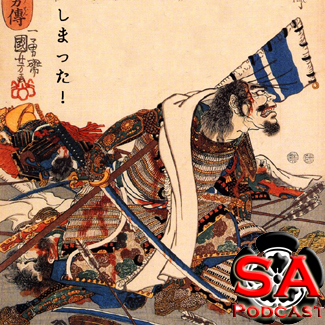
Photo credits: samurai-archives.com
Their training started at the age of 3, and till 7 years old it consisted in learning not to be afraid of death and fighting by controlling their minds and bodys, and to obey to the orders of their master. To toughen their body, they were subject to cold showers under waterfalls or in the snow. This enabled them to resist to external stimuli. Then, they were taught how to use the bow and the sword against imaginary enemies. At the age of 12 they were already able to kill.
The bond with the master could become very special. In the feudal period, sexual practices among men were very common for samurai warriors. According to the translation of the shudo - from wakashudo (the "way of youths") - the pupils spent many years with older men. Men that not only taught them fighting skills but also introduced them to the world of eros. Apprentices would then become their official lovers, in a fully recognised relationship that so required absolute loyalty.
A samurai worked for the daimyō's glory, but their pay consisted in rice. To keep their social status, those samurai who were not born from a rich family relied on secondary works like making small umbrellas or toothpicks. But they made others sell them in their place so not to be compromised themselves. They also had many privileges: for example they could have a surname, something that commoners of the time couldn’t have in Japan. They also had the privilege of the kirisute gomen, or in other words the "right to cut and leave behind". A samurai had the right to kill anyone of inferior status who dared to disrespect them. The only concern was to prove, in a legal debate, that they had been wronged.
Regarding their private and love life, the wife was chosen through an arranged marriage. She had to have a warrior’s lineage, or else be “adopted” into a samurai family to ennoble her origins before the marriage.
But a samurai wife also had a “privilege” (euphemistically speaking): with marriage they too acquired the right to commit the ritual suicide, the jigai, by cutting the throat.
In medieval Japan it was not uncommon to meet samurai women that since their early childhood had been trained according to the values and the martial arts of the warrior class. Samurai of this class practiced martial arts, Zen, the cha no yu (tea ceremony) and the shodō (art of the calligraphy).
In the Tokugawa era they lost their military function and many of them became simple rōnin. By the end of the Edo period samurai had become bureaucrats serving for the shōgun or a daimyō, and their sward was just a ceremonial weapon indicating their status. With the Meiji restoration and the opening of Japan to the west in the XIX century, the samurai class was abolished because it was now considered outdated. Instead, a Western-style army was favored. Two laws, under the Meiji Emperor (1852-1912), marked the end of samurai. One, the Dampatsurei edict, forced warrior servants to give up their topknot haircut to use a western style haircut. The other, less "facade" and even more decisive, was the Haitorei edict, which deprived them of the right to carry weapons in public. To samurai without their katana remained nothing but a small state pension and the refuge provided by folklore.
But bushidō still survives in today's Japanese society.
The weapons
 Photo credits: cdn.history.com
Photo credits: cdn.history.com
Samurai used a large variety of weapons, and indeed a clear difference between European cavalry and samurai concerns the use of weapons. A samurai never believed that there were disgraceful weapons, but only efficient and inefficient weapons. The use of firearms was a partial exception to this, as it was strongly discouraged during the 17th century by the shogun Tokugawa. It came to forbid them almost completely and to distance them from the training of most samurai.
In the Tokugawa period the idea that the katana contained the soul of the samurai started to spread, and samurai are sometimes (though erroneously) described as totally dependent on the sword to fight.
When they had reached the age of thirteen year old, boys of the military class were given, in a ceremony called genpuku, a wakizashi (the sword also used to commit suicide) and an adult name. In other words they became vassals and so official samurai. This gave them the right to bring a katana with them, though it was often secured and closed with laces to avoid unmotivated or accidental drawing. Together, the katana and the wakizashi, are called daishō (literally "big and small"). Their possession was an exclusive privilege of the buke, the military class at the top of the social pyramid.
Bringing this two swords was forbidden in 1523 by the shogun to ordinary citizens who were not sons of a samurai. This was decided in order to avoid armed rebellions since before the reform everyone could become a samurai.
But other than the sword, another very important weapon for a samurai, was the shigetou, the Japanese asymmetrical bow, and this was not modified for centuries until the introduction of gunpowder and musket in the 16th century. The shigetou, 2 meters long and made of laminated and lacquered wood, was a weapon exclusively used by samurai. Until the end of the thirteenth century the way of the sword (kendo) was less considered then the way of the bow by many bushido experts. A Japanese bow was a very powerful weapon: its dimensions allowed to fire with accuracy various types of arrows (such as flaming arrows or signal arrows) at a distance of one hundred meters. They even reached up to two hundred meters when precision was not needed.
During the period of samurai’s greatest power, the term yumitori (archer) was used as an honorary title for warriors even when the art of the sword became predominant. Japanese archers (see the art of the kyūjutsu) are still strongly associated with Hachiman the god of war.
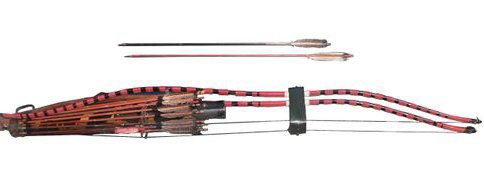
Photo credits: nihonjapangiappone.com
The bow was usually used on foot from behind a tedate, a large wooden shield, but it could also be used on horseback. The practice of shooting while riding a horse became a shinto ceremony called yabusame. In the battles against Mongol invaders, these bows represented a decisive weapon as opposed to the smaller bows and crossbows used by the Chinese and the Mongols.
In the fifteenth century the spear (yari) became a popular weapon. The yari started to replace the naginata when individual heroism became less important on the battlefield and militias were more organized. In the hands of foot soldiers or ashigaru it was more effective than a katana, especially in open-field charges. In the Battle of Shizugatake, where Shibata Katsuie was defeated by Toyotomi Hideyoshi, the so-called "Shizugatake's Seven spears" played a crucial role for the victory.
To complete their armament there were war fans with knife-like edges, but for many periods of Japanese history samurai were the only ones allowed to carry weapons.
Seppuku

Photo credits: focus.it
Seppuku (切腹) is a Japanese term that indicates the ritual suicide performed among samurai. The word harakiri (腹 切 り) is often used in western terminology. In Italian it is sometimes mistakenly pronounced as "karakiri", with an erroneous pronunciation and incorrect transcription of the ideogram ‘hara’.
More specifically, there are some differences between seppuku and harakiri, as explained below.
The literal translation of the word seppuku is "cutting the stomach", whereas for harakiri is "cutting the abdomen" and this act was carried out following a rigidly codified ritual. It was a way to atone for one’s crimes or to escape a dishonorable death by the hand of the enemies. A key element to understand this ritual is the following: the belly was believed to be the seat of the soul. The symbolic meaning of this act was therefore to show to the attendees one’s own soul without fault and in all its purity. But even this extreme gesture of pride and freedom of a samurai followed rigidly codified rules.
The sacrifice had to be consumed in front of witnesses using a dagger (tantō) or the short sword (wakizashi) and executing a "L" cut that, starting from the navel, proceeded from left to right and then upwards.The fingers of the feet bent downward guaranteed that the dying man on his knees would fall forward, covering the blood and guts. The presence of witnesses and of a kaishakunin, the assistant that had the responsibility to finish off the wounded man with a blow at his neck, assured that the victim did not suffer any further (and did not have any second thoughts).
The kaishakunin was the samurai’s trusted companion who, as promised to his friend, would behead him as he had wounded his abdomen to ensure that the pain did not disfigure his face and preserve his honor.
Often voluntarily practiced for various reasons, during the Edo period (1604-1867) it became a death sentence that did not lead to dishonor. In fact, given his position in the military class, the man sentenced to die was not executed but invited or forced to take his own life with a dagger by cutting his own abdomen so severely that it caused his death.
The beheading (kaishaku) required extraordinary skill and in fact the kaishakunin was the most talented swordsman among his friends. Indeed, a mistake caused by poor skills or by emotion would have caused considerable further suffering. The presence of the kaishakunin and consequent decapitation represent the essential difference between seppuku and harakiri. In fact, although the way the abdomen is cut are similar, in the harakiri the man committing suicide is not expected to be beheaded. Therefore, casting aside all the ritualty of the act, it results in an event of lesser solemnity.
The most well-known case of collective seppuku is that of the "forty-seven rōnin", celebrated in the play Chushingura, while the most recent case is that of the writer Yukio Mishima in 1970. In the latter example, the kaishakunin Masakatsu Morita, overwhelmed with emotion, repeatedly failed at severing Mishima's head, and it required the intervention of Hiroyasu Koga to behead the writer.
One of the most accurate descriptions of seppuku is that contained in Algernon Bertram Mitford's Tales of Old Japan (1871), later on resumed by Inazo Nitobe in his book Bushido, The Soul of Japan (1899).
In 1889, with the introduction of the Meiji constitution, it was abolished as a form of punishment, but cases of seppuku were registered at the end of World War II among officers, often from the samurai class, who did not accept Japan’s surrender . Another famous case of seppuku was that of the former daimyō Nogi Maresuke who committed suicide in 1912 after receiving the news of the emperor’s death.
By the name of jigai, seppuku was traditionally performed by women of the samurai class as well. In this case, after tying feet together to avoid disgraceful positions during the agony, they did not cut their belly but the throat.
The weapon used could be the tantō (knife), although more often the choice fell on the wakizashi, especially on the battlefield, and for this reason this blade was also called the "guardian of honor".

Photo credits: wikipedia.org
The Bushidō code
The Japanese warrior lived and died following a strict code of conduct, the bushidō code (the way of the warrior), which governed the unique and inseparable relationship between the samurai and his daimyō. At the core of this code there was absolute loyalty, a rigid definition of honor and the sacrifice of the good of the individual in favor of common good. This was also the ethics behind the actions of Japanese kamikaze during the Second World War, and the same ethics can be traced down to some modern Japanese companies. If an offense or a serious fault had crippled this relationship, there was always one way to save honor: seppuku or harakiri, the ritual suicide.
Samurai's principles were heavily influenced by the main spiritual and cultural currents that coexisted in the country. Towards 1000 Shintoism was still the main source of inspiration for samurai schools that emphasized loyalty to the emperor in an era in which being a samurai meant to be a capable warrior. Subsequently, however, Taoist, Buddhist, and Confucian ideas began to spread and overlap each other. In particular, after the Chinese Buddhism, Zen Buddhism and esoteric Buddhism experienced a great widespread as well. The latter was mainly practiced among the richest and most powerful noble houses, while zen Buddhism was also practiced by small schools and among rōnin. In this era, many schools that believed it was a samurai’s duty to perform his obligations not only to the best of his abilities, but also with grace and elegance, started to spread. This meant that a samurai had to show his superiority through his gestures. This way of thinking, that often encountered some resistance in the sixteenth century, resisted in many schools of samurai.
The warriors of the 900 a.d. had become, before the 1300, sophisticated poets, patrons, painters, art lovers, and porcelain collectors, codifying in many bushido related works (up to the Book of the Five Rings) a precise necessity. In fact, a samurai had to be skilled in many arts, not just in the use of the sword. The first big codification that embodied this important turning point was the Heike Monogatari, the most famous literary work of the Kamakura period (1185-1249). This work attributed to the way of the warrior the obligation to find balance between military force and cultural power. The heroes of this epic narration (the story of a fight between two clans, the Taira and the Minamoto), and others inspired by it in the following years, are gentle and well-dressed, they take care of their hygiene and are courteous with the enemy in periods of truce. But they are also skilled musicians, competent poets, scholars, sometimes especially well-versed in calligraphy or the arrangement of flowers. And more, they were enthusiastic gardeners, often interested in Chinese literature. Also, dying, they often put their epitaph in verse.
This dual nature of a samurai's duties had a remarkable widespread, until it became hegemonic. Hojo Nagauji (or Soun), lord of Odawara (1432-1519), one of the most important samurai of his time, wrote in the Twenty-One Samurai Precepts: "The way of the warrior must always be both cultural and martial. It appears unnecessary to remind that old laws state that cultural arts should be held in the left hand and martial arts in the right". These words seem to emphasized a certain predominance of martial arts, but following this teaching many samurai became famous swordsmans as well as experts in the tea ceremony, or artists, actors in the Nō theater and poets. Imagawa Royshun (1325-1420), a great commentator on Sun Tzu's ‘The art of war’, went even further stating that "Without knowing the way of culture, you will not be able to achieve victory in the martial path." Royshun had thus created a new idea of balance between culture and war known as bunbu ryodo ("never abandon the two ways").
Miyamoto Musashi himself, one of the strongest duellists of the seventeenth century, became, in the second part of his life, one of the most talented painters of that period. He agreed with Takeda Shingen (1521-1573), perhaps the greatest commander of the sixteenth century, who claimed that the greatness of a man depended on the practice of many ways.
This attitude obviously caused a whole series of harsh criticisms. In particular, we must mention Kato Kiyomasa's aversion (1562-1611) to everything that was not martial, and his opinion, shared by many "extremely martial" schools, was that a samurai devoted to poetry would become "effeminate", while a samurai who was also an actor or was interested in Nō theater should have committed suicide for the dishonor he was bringing upon his name.
"Extremely martial" way of thinking and a refusal of the cultural aspects of the samurai figure spread out in the following centuries. This may seem paradoxical for a time of peace (the so-called Pax Tokugawa) during which etiquette was not only accepted in small dojo, but it was also studied thoroughly. At the same time, however, there was a clear intention to return to the original meaning of being a samurai, a fearless warrior.
The different sources of cultural inspiration to which samurai were subjected (shintoism, esoteric shintoism, Taoism, Chinese Buddhism, pure earth Buddhism, Zen Buddhism, Esoteric Buddhism, Chinese Confucianism, Confucianism of Japanese glossators and Japanese classical epics) created different schools of thought and practice. Sometimes they followed opposing principles of life, but more often they were simply complementary, also thanks to the great attitude to pragmatism and the syncretism that characterizes Japanese culture.

Photo credits: wikipedia.org
Symbol of all martial arts. In the classical iconography of the warrior, cherry blossoms represented the beauty and caducity of life and were therefore revered. The sakura, when in full bloom, show a lovely sight in which the samurai recognised the magnificence of his figure wrapped in his armor. But it takes just a sudden storm to make all the flowers fall to the ground, as a samurai can fall by the sword of his enemy. The warrior, accustomed to the idea of dying in battle not as a negative thing but as the only honorable way to part with the world, reflected this philosophy in the cherry blossom .
An ancient verse still known today says "Among flowers the cherry blossom, among men the warrior" (花 は 桜 木人 は 武士 hana wa sakuragi, hito wa bushi), or "as the cherry blossom is the best among flowers, so the warrior is the best among men."
Japan History: Minamoto no Yoshitsune
Minamoto no Yoshitsune
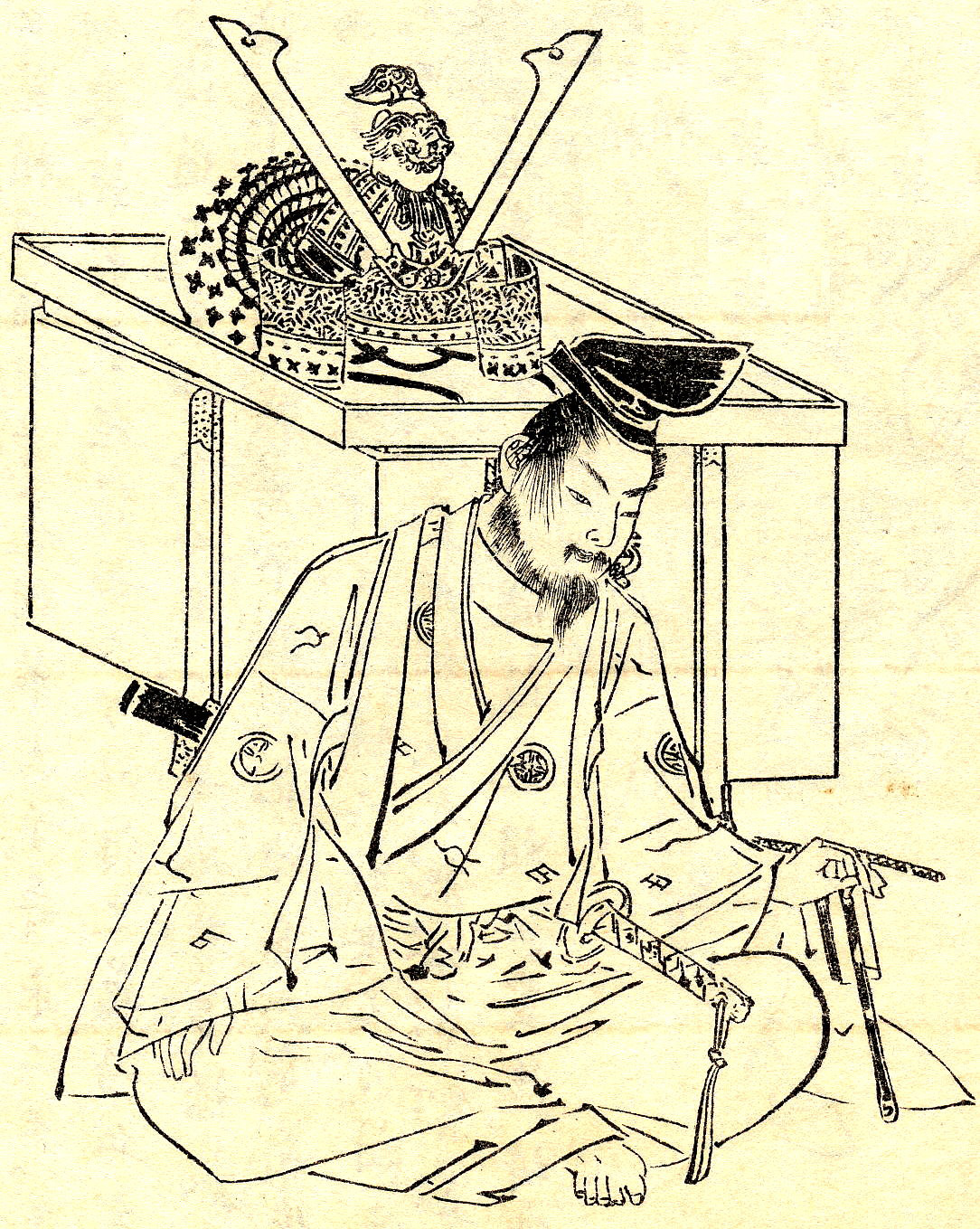 Photo credits: wikipedia.org
Photo credits: wikipedia.org
Yoshitsune was the ninth son of Minamoto no Yoshitomo, and the third child he had with Tokiwa Gozen. Yoshitsune's childhood name was Ushiwakamaru (牛若丸). Shortly after his birth, Heiji's rebellion broke out, and his father and his two older brothers lost their lives. While his older brother Yoritomo, now the designated heir of the clan, was exiled to the province of Izu, Yoshitsune was entrusted to Kurama temple, in the mountains of Hiei near Kyoto. He was then put under the protection of Fujiwara no Hidehira (藤原秀衡), head of the powerful branch of the Fujiwara clan in the North (Northern Fujiwara), and brought to Hiraizumi, in the Province of Mutsu.
 Photo credits: wikimedia.org
Photo credits: wikimedia.org
In May 1180, the son of Emperor Go-Shirakawa, that was supported by the Minamoto clan, issued a statement urging the Minamoto to rise against the Taira. The context is that of the Genpei War (1180-1185) which saw the clans Taira and Minamoto fight for the choice of the rightful Emperor to be put on the throne and thus secure control over the Country. The Battle of Uji was the beginning of a 5-year war during which Yoshitsune and Yoritomo met again after their separation in 1160.
In 1184 Yoshitsune went against his cousin Yoshinaka. Yoshinaka had taken control of the Minamoto clan after defeating the Taira in June of 1183. At that point, Yoritomo sent his brother Yoshitsune against Yoshinaka, who had obtained in the same year the position of Sô-daisho (general of the army). Yoshinaka's troops were defeated and, as soon as he learned that, he abandoned Kyoto along with Tomoe Gozen, the only example of female samurai warrior. He was soon cornered at Awazu and committed suicide. With Yoshinaka out of the way, Yoritomo secured the support of Go-Shirakawa to continue the war with the Taira. On March 13 Yoshitsune moved to Settsu, and his first objective was a Taira fortification, Ichi no tani.
Yoshitsune led in battle 10,000 men attacking from the West, while 50,000 men led by Noriyori, Yoshitomo's brother, attacked from the East. On March 18 Yoshitsune arrived in Mikusayama, attacking at night. According to the Heike Monogatari, the surviving defenders fled to the coast and passed over to Shikoku, leaving 500 dead. Yoshitsune then sent 7,000 men under Doi Sanehira down to the western side of Ichi no tani while he led the remaining 3,000 men down the top of the cliffs. The Minamoto won over the Taira, and their victory cleared the way for an assault on Yashima, the Taira headquarters on Shikoku.Yoritomo opted for a cautious approach. The next six months were spent consolidating the gains already made and sorting out the families who had thus far supported the Minamoto.
After Ichi no tani, Yoshitsune and Noriyori returned to Kyoto and paraded the Taira heads taken through the streets. In the following October Noriyori was dispatched to destroy Taira adherents on Kyushu, and began a long and tiring march through the western provinces. Yoshitsune stayed in Kyoto acting as Yoritomo’s deputy there into early 1185. Officially, he was responsible for issuing decrees ordering the termination of any violence within Minamoto territory. In practice, his directives covered various other issues, including the forbidding of war taxes without the express consent of the Minamoto leadership.
During Yoshitsune’s time in Kyoto the rift between him and Yoritomo became evident. It seems that Yoritomo had denied him the titles that the imperial court had granted Yoshitsune, and that he became furious when the court proceeded and approved the titles anyway.
In March 1185, with Noriyori preparing to invade Kyushu, Yoshitsune was authorized to return to the war. Intending to launch an assault on Yashima, he assembled a fleet of ships at Watanabe. During the preparations he argued with Kajiwara Kagetoki, one of his elder brother's closest retainers, about strategy, but in the night of March 22 Yoshitsune ordered to his men to set sail. Since the weather was extremely bad many sailors refused to go to sea, and departed only after Yoshitsune threatened to kill any man who disobeyed his orders. Even still, not all of the ships followed him.
Yoshitsune landed on Shikoku at dawn and set out for Yashima. The Taira base was situated on the beach and Taira Munemori, alerted by fires set nearby by Yoshitsune’s men, ordered an immediate evacuation of the fort. He himself fled to the ships with Antoku, the child Emperor protected by the Taira. Nonetheless, the Taira clan was completely eradicated in what is remembered as the battle of Dan-no-ura, one of the greatest battles of Japanese History.
After this victory, in 1192 Yoritomo was granted the title of Shogun. However, by that time, Yoshitsune was already dead because Dan-no-ura marked not only the ultimate recognition of his ability and fame, but also his tragic end. In fact, for a long time the relationship with his brother had been turbulent. And probably, the jealousy for the skills demonstrated so far by Yoshitsune played a role in Yoritomo's choice to declare his brother a threat to the Minamoto clan and the Empire itself.

Photo credits: wikimedia.org
After attempting to oppose Yoritomo, Yoshitsune was forced to find shelter at Mutsu, where there was his old guardian Fujiwara Hidehira. But Hidehira died in November 1187 leaving a will stating that Yoshitsune was to act as governor of Mutsu. A wish Hidehira's son, Yasuhira, ignored completely. A conflict broke out with the Fujiwara and inevitably the Kamakura authorities learned of Yoshitsune’s location. Benkei, Yoshitsune’s retainer and loyal companion, managed to hold off their assailants long enough for Yoshitsune to kill his young wife and commit suicide. The head of Yoshitsune was transported to Kamakura, where it provoked an emotional response from those who viewed it.
He was buried in the shintoist temple of Shirahata Jinja, in Fujisawa, where his remains are still guarded.
Myths and legends
In spite of all, information about Yoshitsune's death have always been a bit elusive. According to the Ainu historical accounts, he did not commit seppuku, but fled to Koromogawa taking the name of Okikurumi/Oinakamui.
In Hokkaido, the temple of Yoshitsune was erected in his honor in the town of Biratori. Some theories see him run away to Hokkaido and resurrect as Genghis Khan. But of course these are just legends.

Photo credits: samurai-archives.com
A remarkable soldier and a classical tragic figure, Yoshitsune was a legend even before his passing. Kujô Kanezane, a supporter of Yoritomo, wrote in his diary in 1185:
"Yoshitsune has left great achievements; about this there is nothing to argue. In bravery, benevolence, and justice, he is bound to leave a great name to posterity. In this he can only be admired and praised. The only thing is that he decided to rebel against Yoritomo. This is a great traitorous crime."
The manner in which Yoshitsune died assured him an honorable place in posterity, while the memory of Yoritomo will forever bear a black mark. What happened in those summer months of 1185 will always be a mystery. But it is certain that Yoshitsune’s achievements in the Gempei War changed the course of Japanese history and earned him a place among the greatest samurais.
Yoshitsune’s life in literature and in modern era
In spite of his military abilities, Yoshutsune’s life met his end in a bloody way that inspires sympathetic response among many people. In Japanese, the expression Hougan’biiki (判官贔屓), that means ‘sympathy and benevolence for the underdog’, includes Yoshitsune’s posthumous name, Hougan (判官). This name was given to him thanks to the position that Emperor Go-shirakawa had granted him, in fact, another way to pronounce the word is Hangan, that means ‘magistrate’.
Furthermore, Yoshitsune’s life is considered to be heroic to the point of being narrated. Legends and tales with this theme grew in number as time passed, and so Yoshitsune’s fame took a shape that was far away from its original historical self. Among the many legends, well-known is the one about his encounter in Oobashi with the strong Musashi. Or the one in which, thanks to shaman Kiichi Hogen’s daughter’s help, he was able to steal 2 legendary volumes of military strategies, Rikuto e Sanryaku, and study them. Or even more, the one about the sudden death of Benkei, warrior monk, loyal servant and friend, that died still standing on his feet in the Battle of River Koromogawa. These legends grew in popularity among a wide audience in the Muromachi period, about 200 years after his death, thanks to ‘Yoshitsune’s Chronicle’.
In fact, Yoshitsune appears as the protagonist of the third section of the Heike Mongatari, the classic tale that narrates the Genpei War events and that inspired many later works, especially in No and Kabuki tradition. In particular, it is said that his victory in the Sunaga battle had been due to his studies on the Tiger Book, contained in the Rikuto scroll, and that since that moment, that same book became essential for future victories. In later periods, Yoshitsune’s name was used to legitimize the glory of a lineage. For example, there is a martial arts school that is supposed to have inherited its technique from Yoshitsune himself or from the one that is considered his mentor, Kiichi Hogen.
MOON SAGA and MOON SAGA 2
Yoshitsune's figure was also portrayed by Japanese singer and actor GACKT in the theatrical plays MOON SAGA and MOON SAGA 2. He himself interprets Yoshitsune describing him as a mononofu, a half-human and half-demon being. GACKT, with his exceptional interpretative skills, was able to portray this duality perfectly, giving life, in the first part, to an ironic, funny and somewhat awkward character that in the second part becomes demonic and scary. The adventures of Yoshitsune are, in this case, fictionalized and mixed with a bit of supernatural elements, but they still tell his story, because Yoshitsune was like that. A duality, a character full of contrasts in which benevolence alternated with cruelty. Probably, Yoshitsune used to lose control completely when facing danger and for that reason he’d unleash his "demon" side.
MOON SAGA 2 was also the first theatrical representation in the world to use the projection mapping.

Photo credits: gackt.com

Photo credits: gackt.com
Japan History: Maeda Keiji
Maeda Keiji

Photo credit: wikipedia.org
Maeda Toshimasu, (1543-1612) also known as Maeda Keiji or Keijiro, was a Japanese samurai who lived in the Sengoku Period (1467-1568).
Born in Nagoya, he was the son of Takigawa Kazumasu, who was later adopted by his uncle Maeda Toshihisa, brother of Maeda Toshiie. He served under Oda Nobunaga with his uncle and was initially the heir of the clan. However, Nobunaga replaced Toshihisa with Toshiie as head of the Maeda family, and Toshimasa lost this position. At that point, the disagreements between him and his uncle Toshiie began, and it is said that they often quarrelled.
In 1581, he made a reputation for himself under his uncle’s command in a conflict in the Province of Noto. During the Battle of Komaki-Nagakute, three years later, Toshimasu saved Sassa Narimasa when he was attacked at the Castle of Suemori.
In Kyoto, he met Naoe Kanetsugu the karō (samurai and senior advisors at a daimyō service) of Uesugi Kagekatsu. The two of them became friends and Toshimasu joined the Uesugi clan in the invasion of Aizu. The invasion failed, and Keiji led the rearguard during the retreat.
In the battle, however, he was able to give a splendid show of force riding on his inseparable horse Matsukaze, 'the wind among the pines', while brandishing his spear. Due to Keiji’s actions, the Uesugi's forces were able to retreat intact, while the samurai returned to the capital devoting himself to art and literature.
He was later barred from Toyotomi Hideyoshi’s campaign in Kyushu for his wild behaviour. But when Tokugawa Ieyasu challenged the Uesugi clan in 1600, Keiji once again fought with them.
In the battle against the Mogami, legend says that he succeeded in breaking the enemy lines with only eight riders, shattering their formation.
After the Uesugi clan retired in the Yonezawa Domain, Toshimasu remained with them.
According to the legend, after Keiji’s death, his horse Matsukage, that shared with his master the same indomitable personality, ran away never to be found again. It was a magnificent horse that no one else but Keiji had been able to tame, and so powerful to carry his master’s large frame.
It is still possible to see Keiji’s armour at the Miyasaka Museum.

Photo credit: wikipedia.org
Keiji - Hana no Keiji

Photo credit: vignette3.wikia.nocookie.net
The character of Keiji Maeda was so characteristic and so eccentric that he was chosen as the protagonist of a series of manga, Keiji ( 花の慶次 - Hana no Keiji). The story is written by Keichiro Ryu and drawn by Tetsuo Hara, better known for his other work, Fist of the North Star.

Photo credit: Google images
The manga tells the adventures of the greatest kabukimono that ever existed in Japan. A kabukimono is an eccentric person who loves to stand out from others for his behaviour and his appearance, and who has the ultimate goal of imposing his will on others.
Keiji is the son of Takigawa Masuuji and one of his concubines. At that time, the Maeda family was a vassal of the Takigawa clan, and during a reception, Maeda Toshihisa met the girl and asked Takigawa for permission to marry her. On the wedding night, the bride confesses she is already pregnant with her former lord. But instead of killing her (as it was customary in an era where honour and noble blood were fundamental) Toshihisa adopted the child.
Thus, at his birth Keiji (whose full name is Keijiro Toshimasu Maeda) officially became Toshihisa's son and so nephew of Maeda Toshiie, one of the richest Japanese feudal lords of the Sengoku era. During this time, great battles take place in order to decide who will rule Japan after Oda Nobunaga. Keiji, raised on battlefields and gifted with great strength, participates in many of these events.

Photo credit: ayakashi-ghost-guild.wikia.com
His character has a strong sense of honour and personality that follows the basic principle of being a kabukimono to the fullest. Therefore, Keiji seeks to always impose his own will, aware that this means being free to act as he pleases, but also to be killed "like a dog".
Despite the eternal struggle with his uncle, who tried to kill him repeatedly, Keiji remained in the clan and so under his uncle's authority until Toshihisa's death. It was after that when he began to behave in such a way that got him expelled from the clan. This will save the honour of the clan itself since a samurai who voluntarily abandons his master dishonours him.
The Characters
Various fictional characters accompany Keiji in his travels and adventures.
In the first chapter of the manga, Keiji meets and binds with the "diabolic" horse Matsukase, "wind in the pines" (a copy of Black King, horse of Raoh – Fist of the North Star). It is an unusually big animal and therefore able to endure Keiji's weight, but no one else can ride it. Since then, the two of them are inseparable.
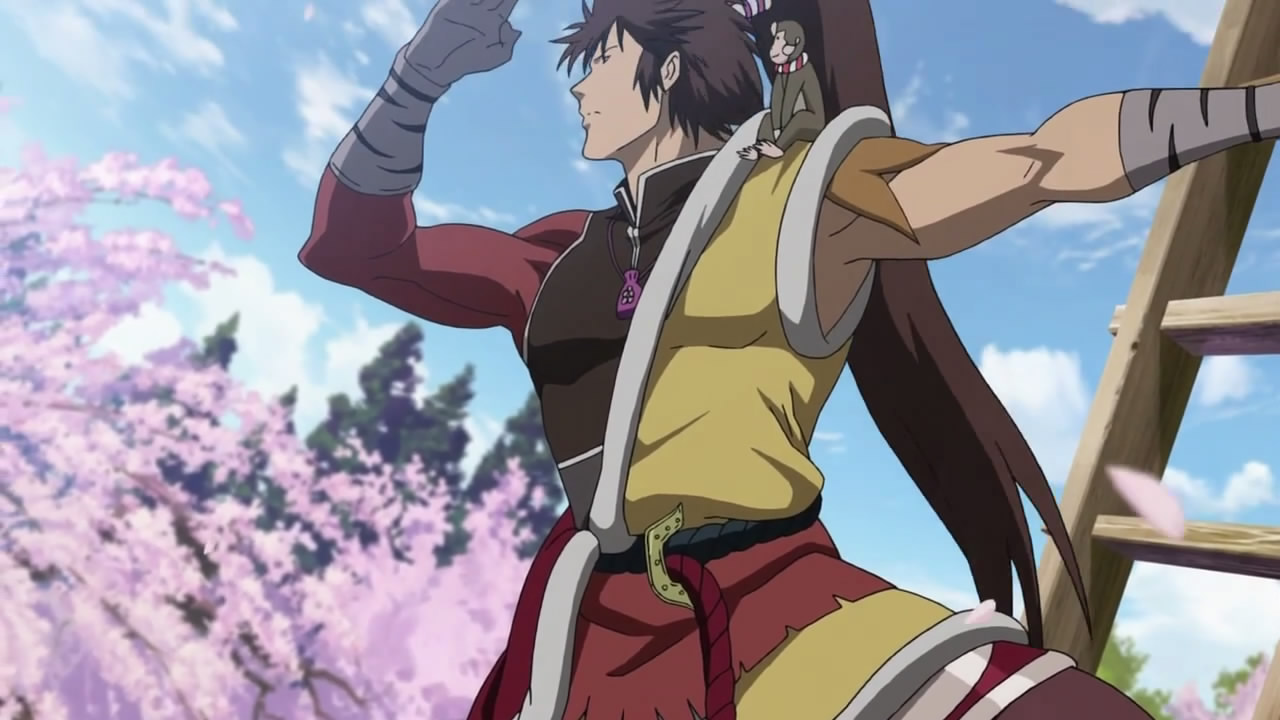
Photo credit: Google Images
For a time Keiji was accompanied by little Ofu. He meets the girl when he was challenged by the martial arts expert named Gankibo. Ofu had to follow him carrying a bucket on his head where he gathers the ears of dead enemies. The spirits of the fallen torment her and when Keiji defeats Gankibo he frees Ofu from her task, giving peace to the spirits as well. Ofu was actually 14 or 15 years old but looks like a little girl because she has decided not to grow.
The little shinobi Sutemaru is the first vassal to serve Keiji. At first, Sutemaru is part of Kaga's ninja clan serving Maeda Toshiie, and wants to kill Keiji and Matsukase (the horse who trampled and killed his brother). But soon Sutemaru decides to abandon the ninja clan to stay with Keiji, who he faithfully serves in hope of succeeding in killing him. Sutemaru fights with edged weapons, kunai and explosive weapons, as well as being often an explorer for Keiji. Peculiar of his character is the fact that he always hums when he fights and cannot lie because each time he does, his eyes become strabic.
The last important character is Lisa, a beautiful young woman with blond hair. Her father, Yoshiro, is the son of Sen no Rikyu and a Western woman, carried as a slave on a European pirate ship that will clash with Sakai merchants. Yoshiro will meet Keiji and show him a portrait of her daughter. The kabukimono will fall in love with the girl, who is desired by the Spanish pirate Carlos and the king of Ryukyu (now Okinawa, the main island of the Ryukyu archipelago) as well.
Instead, among the historical figures met by Keiji, there surely is his uncle Toshiie Maeda (also known as Mataza the lancer), the kanpaku (Emperor Regent) Hideyoshi Toyotomi, and Tokugawa Ieyasu his successor; but also Nobunaga Oda, former master of Hideyoshi and Ieyasu, and Hattori Hanzo, chief of Iga's ninjas at Ieyasu’s service. He will also meet the aforementioned master of ceremonies Sen no Rikyu, and the military commander of Yamashiro region (where the capital of the time was, Kyoto) Kanetsugu Naoe. Also, the Lord of Kanetsugu, Kagekatsu Uesugi, nephew and successor of the famous daimyo Uesugi Kenshin; Mitsunari Ishida, Hideyoshi’s favourite and Kanetsugu Naoe’s cousin, and Date Masamune, daimyo of northern lands of the country.
After Sekigahara’s Battle, where Mitsunari Ishida and Ieyasu Tokugawa are fighting for the control of the country, Keiji happens to find himself on the losing side. He was actually deployed and enlisted as Kanetsugu Naoe’s vassal to help the Uesugi clan. Ieyasu had provoked the Uesugis to seek war for the sole purpose of making Mitsunari move and expose himself. Keiji then decides to meet Ieyasu as an ambassador of the Uesugi clan. He shaves his long hair like a bonzo and gives up the compensation he is entitled to receive as a samurai of the clan. After peace was made, he decides to stay out of the scene until Kanetsugu asks him to go with him in his feud, request that Keiji accepts. The next morning, he gives up all his money and sets up an improvised party. The balloons tell us that he will move with Lisa in Nao's clan and cease to be a kabukimono.
He will die about 12 years later, under the reign of Tadakatsu Uesugi, heir of Kagekatsu.
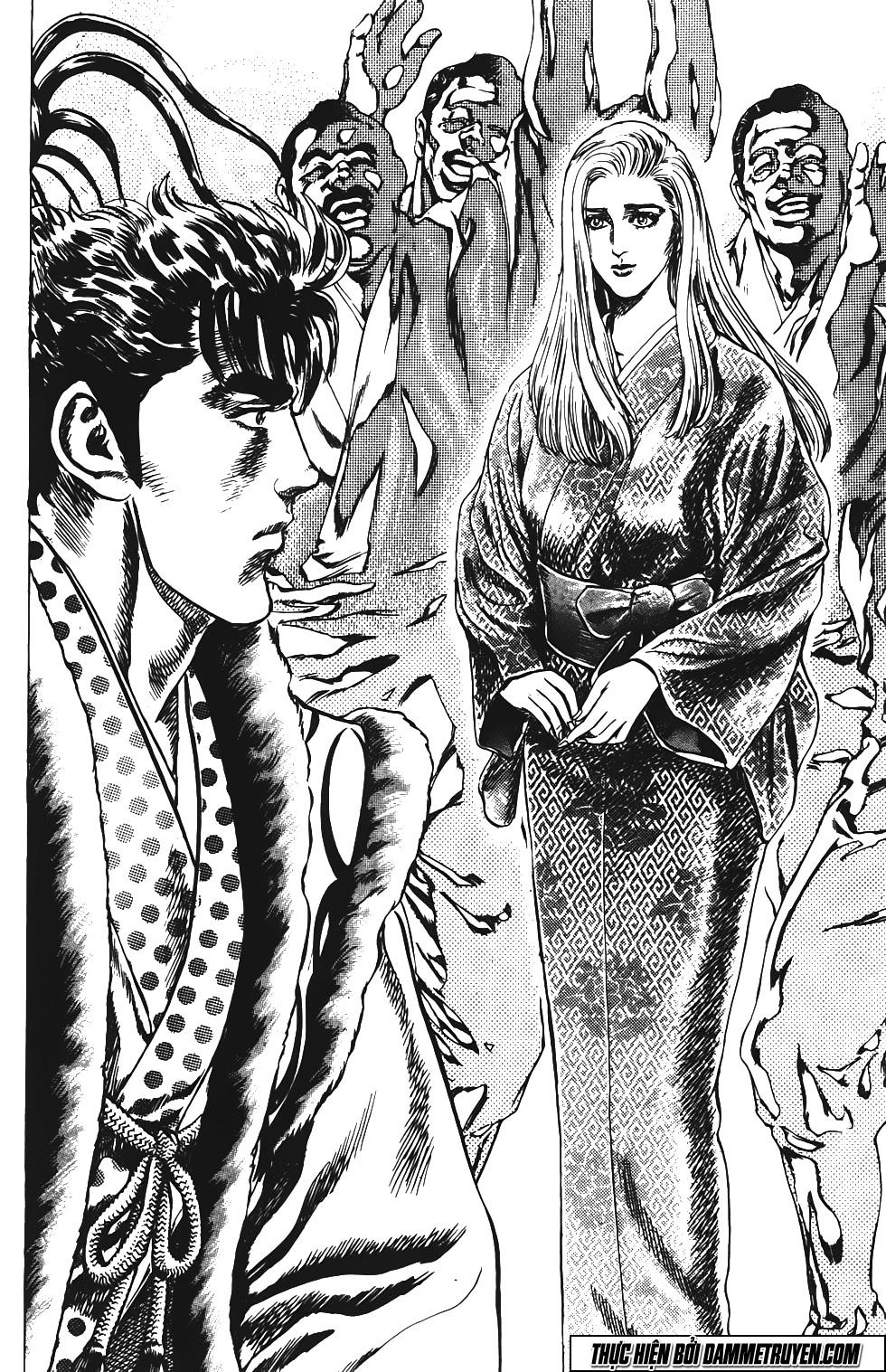
Photo Credit:truyentranhpro.com
Sengoku Basara
Sengoku Basara (戦 国 BASARA) is an anime divided into two series, based on the Devil Kings, a video game series released by Capcom, each consisting of thirteen episodes. A three-volume manga called Sengoku Basara Ranse Renbu is also based on the video game. The manga, created by Kairi Shimonotsuki and published by Udon Entertainment, is published in Italy by J-Pop. Instead, the two seasons of the anime were purchased by Yamato Video that announced it via Facebook and is part of the “Secret Project” of the Milanese publisher. The series is being broadcast on the new Yamato youtube channel from October 30, 2013.
On June 4, 2011, the feature film Sengoku Basara: The Last Party was released in Japan.
The following year, a live-action adaptation, Sengoku Basara: Moonlight Party was aired from 12 July to 20 September 2012.
Two years later, in 2014, the third television series, Sengoku Basara: Judge End, that inspired to the story of Sengoku Basara: Samurai Heroes of the video game, was aired.
Personally, I think that Keiji's character is very interesting, and above all, I think he needs to be more thoroughly comprehended. His personality differs from the others, and he is able to go against the seriousness characterizing the Samurai figure. I feel very close to him as an unstable and eccentric soul, always looking for something he can’t get but that is probably in his hands already. His way of breaking the schemes going as far as playing tricks on his relatives, the fact that he doesn’t care about etiquette and who he is. As well as his feeling a child in a body that is too big, especially for the time, and his being different, makes him a person that needs to be discovered and loved.
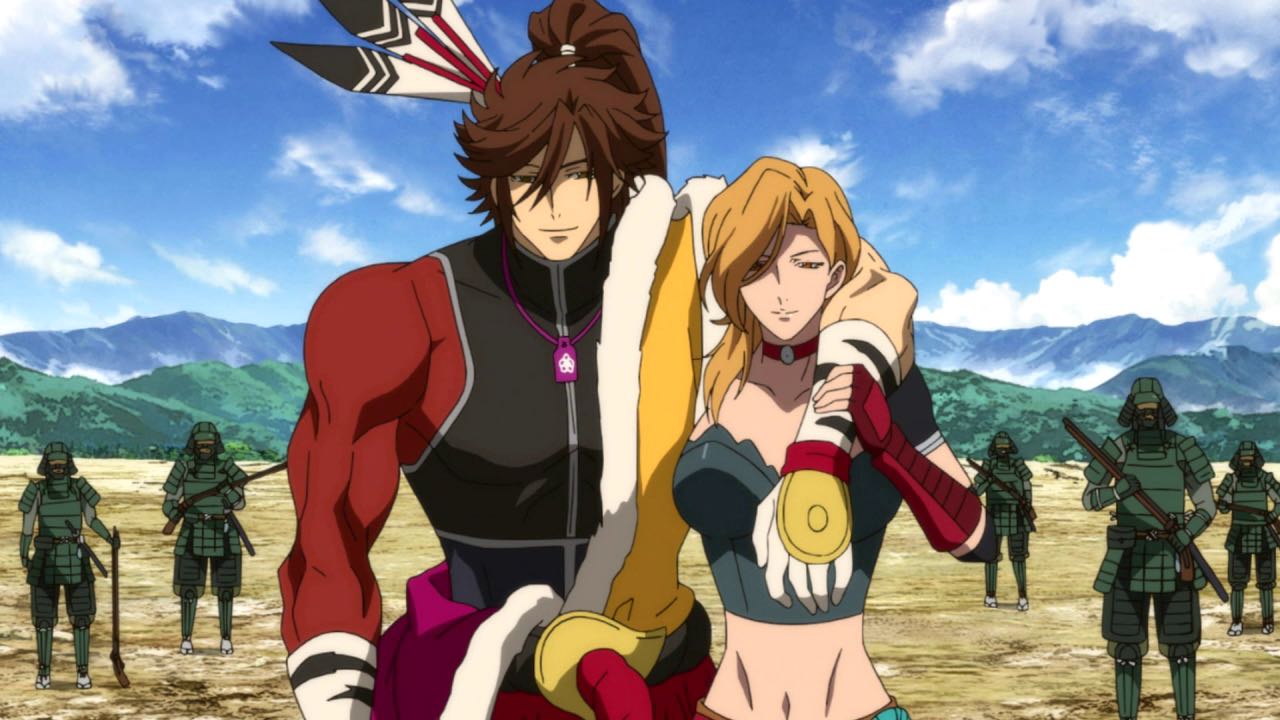
Photo credit: www.Tumbr.com
And there is also his love for Lisa that was one of the first times in which the East-West relationship was showed. A samurai who fell in love with a European woman was at that time a sort of scandal and something absolutely unusual. A beautiful story between the two, which continues to be a source of inspiration for other comics and video games.
“Everyone is weak and relies on others. As we reach out to each other, as we become friends or fight, the bond we form creates our tomorrow. “
Keiji Maeda - Sengoku Basara

Photo credit: Google Images
Japan History: Uesugi Kenshin
Uesugi Kenshin

Photo credit: wikipedia.org
Uesugi Kenshin,( 上杉 謙信) "The Dragon of Echigo" , powerful war lord and brilliant strategist, wise administrator and man of honor. Many are the names he used in his intense life, many the battles and the enemies he fought. Among them Takeda Shingen and the famous Oda Nobunaga who is said to have rejoiced when he heard of his death. Such were Uesugi’s fame and power, and it is about him that we want to talk about this time.
Uesugi Kenshin was born as Nagao Kagetora (長尾景虎)on February 18, 1530 and died on April 19, 1578. He changed his name to Uesugi Masatora inheriting the Uesugi clan name when he became the official Kantō Kanrei (vice-shōgun of the Kantō region). To honor the 13th shogun Ashikaga Yoshiteru he changed his name again to Uesugi Terutora, finally changing it for the last time to Kenshin, the name we all know. This happened after he vowed to become a Zen-Buddhist and especially a devotee of Bishamonten, god of war.
Kenshin was referred to as "The Dragon of Echigo" because of his fearsome skills in the martial arts while his rival Takeda Shingen was called "The Tiger of Kai". In fact, in some versions of Chinese mythology, the Dragon and Tiger have always been bitter rivals who try to defeat one another, but neither is ever able to gain the upper hand.
Early life

Kenshin was the fourth son of the noted warrior Nagao Tamekage from the Nagao clan. His father was considered a great war lord thanks to his victories over Uesugi Sadanori and Uesugi Funayoshi. But Tamekage soon started a conflict with his neighboring Ikkō-ikki of Hokuriku, as the political power in the region had started to shift in favor of the Ikkō. The situation for Echigo quickly deteriorated until Kenshin’s father in 1536 gathered up an army and marched westward. However, upon arriving in Etchū, his forces were suddenly attacked by Enami Kazuyori, and Tamekage himself was slain.
Then Nagao Harukage, Tamekage's eldest son, immediately took control of the Nagao after defeating his brother Kageyasu who died in the conflict. Kagetora (Kenshin) was relocated to Rizen temple where he spent his time studying.
Until he reached 14, when he was contacted by Usami Sadamitsu and a number of other acquaintances of his late father. They urged him to go to Echigo and contest his older brother's rule. Harukage had not been able to control powerful kokujin families tearing the province apart.
Even though Kenshin was reluctant to take the field against his own brother, he was eventually convinced that it was necessary to the survival of Echigo. During one of the many clashes, in 1547, he was able to take control over the clan from Harukage. We don’t know what happened to his older brother then, we don’t know if he was ordered to commit suicide or not.
Though his rule over the Nagao and Uesugi clan were now unquestioned, much of Echigo was still independent. He immediately set out to cement his power in the region. Ogasawara Nagatoki and Murakami Yoshikiyo, two Shinano lords, both appeared before Kenshin requesting his help in halting the advance of the powerful warlord Takeda Shingen. Around the time Kenshin had become the new lord of Echigo and Shingen had won major victories in Shinano Province. With the Takeda's conquests taking them remarkably close to the borders of Echigo, Kenshin agreed to join battle.
Uesugi and Takeda

Photo credit: wikipedia.org
What followed was the beginning of a rivalry which became legendary. It started of with indecisive skirmish for a total number of five such engagements at the famous site of Kawanakajima.
In 1561, in the fourth and biggest battle they would ever fight, Kenshin used an ingenious tactic. It was a special formation where the soldiers in the front would switch with their comrades in the rear, as those in the front line became tired or wounded. This allowed the front line to always have strong and fresh soldiers. The tactic was extremely effective and Kenshin nearly won the battle a number of times. It is also said that Kenshin managed to ride up to Shingen and slashed at him with his sword. Shingen fended off the blows with his iron war fan. So Kenshin failed to finish Shingen off before he could organize a counter-attack.
The Uesugi army was forced to retreat. The result of the fourth battle of Kawanakajima is still uncertain, we still don’t know if it was Kenshin to prevail, or Shingen. But one thing is certain, both of them lost a large number of soldiers. Kenshin lost up to 3000 Samurai while Shingen lost 4000 men, also losing his younger brother, Takeda Nobushige.
Though Kenshin and Shingen were sworn rivals for more than 14 years there was often an exchange of gifts between them.The most famous one was a precious sword that Shingen gave Kenshin.
Shinge died in 1573. It is said that Kanshin cried for the loss of his great rival and vowed to never attack Takeda’s lands again. The two parties became allies in three years. In addition, there was an incident when some daimyos boycotted salt supplies to Kai province. Kenshin also heard of Shingen’s problem with the Hojo clan that had refused to send him rise. So Kenshin secretly sent to the Takeda clan some salt supplies. He also wrote to his enemy, Shingen, that according to his information some of the Hojo clan had committed a hostile action. Even if he could have cut out his supplies and so defeat Shingen, Kenshin decided not to do so because it would have been a dishonorable act. As personal reflection, Kenshin said: "I do not fight with salt, but with the sword" . His actions towards his rival set a noble example that can apply to all times. Those seeking peace often use Kenshin’s statement referring to it like :"Peace is achieved with rice and salt, not with katanas and spears".
Kenshin and Oda Nobunaga
「四十九年 一睡の夢 一期の栄華 一盃の酒」
This life of forty-nine years is passed in a dream;
Even a life-long prosperity is but one cup of sake;
Part of Kenshin’s death poem.
Starting in 1576, Kenshin began to consider the issue of Oda Nobunaga. In fact, he had since grown to be Japan's most powerful warlord of the time. With both Takeda Shingen and Hōjō Ujiyasu dead, Kenshin was no longer blocked off from this realm of expansion. So, when the death of a lord in Noto Province sparked up confusion and conflict in the area of the succession, Kenshin was quick to use the opportunity. Taking the land from the weakened clan put him in the position to threaten Nobunaga and his allies. In response, Nobunaga pulled together his own forces and those of his two best generals, Shibata Katsuie and Maeda Toshiie, to fight Kenshin, in the famous Tedorigawa battle. The expert warrior Shibata Katsuie , who had served Nobunaga from the beginning, was sent to test Kenshin’s ability on the battlefield. According to some sources, Shibata brought 18.000 to battle, and was followed by Nobunaga himself with 20.000 as backup. If this numbers were to be proven as correct, this would be the greatest battle of the Sengoku period.
Despite Nobunaga's overwhelming numbers, Kenshin managed to score a solid victory on the field. At first, Kenshin refused to engage the Nobunaga’s army until heavy rain neutralized Nobunaga’s foot soldiers. Forced to retreat, Shibata joined the main force. Then Kenshin used one of the tactics of his old rival Takeda Shingen. He pretended to send forth a small unit to attack Nobunaga's main force from behind and gave his enemy a great opportunity to crush his remaining force. Nobunaga took the bait. His force attacked at night expecting a weakened opponent at the front; instead, Kenshin's full military might was waiting. After the loss of almost a quarter of his military force Nobunaga retired toward Omi Province. Kenshin just took the chance to build some fortress in Kaga province before going back to Echigo. In October 1577, Uesugi Kenshin arranged to put forth a grand army to continue his assaults into Nobunaga's land. But we know that his health was already compromised at the time and on April 9 (according to the calendar of the Tenshō era) it deteriorated. He died four days later.
Uesugi Kenshin's death
The cause of Kenshin's death has been questioned throughout the years. The theory accepted by most Japanese scholars is that a life as a heavy drinker and probably a stomach cancer caused the end of this great war lord’s life.
However, it is also speculated that he was victim of one of the most famous ninja assassinations; a ninja had been waiting in the cesspool beneath the latrine at Kenshin's camp with a short spear or sword. (Note that the theories are not mutually exclusive — the assassin, if he existed, might simply have fatally wounded an already-dying man. )
It is said that when Nobunaga heard of Kenshin’s death he said : "Now the Empire is mine."
Kenshin’s death had dramatic consequences for his clan. While he never had children of his own, he had adopted 2 boys so that they would become his heirs. However, heard of their father’s death they started to fight each other. The conflict ended with Uesugi Kagekatsu’s victory over his brother Kagetora, becoming the new head of the clan. This internal conflict had its consequences in terms of cost and energies too. Oda Nobunaga had no problems in taking over many territories that had once been property of the Uesugi clan. The destruction of the the clan had never been so close and only Oda Nobunaga's own death once again shattered the balance of power in Japan.
Trivia

Photo credit: gacktitalia.com
Uesugi Kenshin’s historical figure and his fame have never been forgotten.
The visual kei singer GACKT played the role of Kenshin in the tv series Furin Kazan, aired from January 7, to December 16, 2007.
In August (The fourth Saturday and Sunday of the month) takes place in Jōetsu,Niigata prefecture, a festival to honor the great warrior, with the reenactment of the famous Kawanakajima battle. In the Sengoku period Jōetsu with its Kasugayama castle was the center of the Uesugi domain.
GACKT himself took part in the festival many times in the role of Kenshin, with a tremendous public success.
The writer Shino Ayako, that wrote the book "Kenshin Woman", expresses her doubts about Kenshin’s identity. There are many rumors that want Uesugi Kenshin to be a woman.
(1) He never had a wife (nor any concubine) and he never had natural children. It is said that he preferred male company to beautiful female’s company. Homosexuality might be an explanation since at the time it was a normal practice among the samurai class.
(2)Some believe that the cause of his death might have been “omushi”, which was documented to be a kind of disease related to menopause
(3)Rumors say that he would confine in the castle once a month.
(4) With reference to his armor, he had a petite stature at about 156 cm in height.
(5) He preferred wearing clothes which were in woman’s colors.
There are no proofs to support this hypothesis, but it is certain that they are still alive even today to testify that Uesugi Kenshin has left an indelible mark on Japanese History.
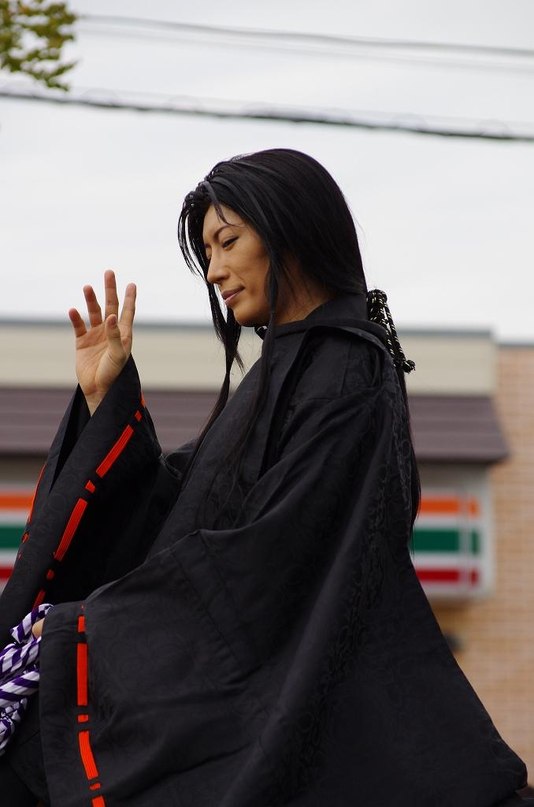
Photo credit: gacktitalia.com
Japan History: Oda Nobunaga
Oda Nobunaga

A copy of Oda Nobunaga's portrait by the Italia painter Giovanni Nicolao, probably commissioned by Nobunaga himself.
Oda Nobunaga is the son of Oda Nobuhide one of the daymio from the Owari province. When his father died in 1551, he started to go completely crazy taking the distance from the Oda clan allies, preferring his brother Nobuyuki.
Even if he was Nobuhide's heir, he wasn't sure to be able to succede him. The Oda clan was subject to Kanrei Shiba Yoshimune, head of this clan was Nobunaga's uncle, Nobutomo. Even Nobutomo had Yoshimune killed when he tried to help Nobunaga. Despite that, he managed to get help from another uncle, Nobumitsu up till he conquered the castle of Kiyosu. Here Nobutomo was killed and Nobunaga lived here for the next 10 years.
Oda Nobunaga also, thanks to the alliance with the Imagawa clan and the Kira clan, was able to move his army in the Mino province (1555). All this to help Saitō Dōsan. However, ths campaign proved to be a failure because Dōsan was defeated in 1556 and Yoshihatsu took his place.
A few months later, Nobuyuki, Shibata and Hayashi Katsuie Hidesada, challenged Nobunaga to control the Oda clan, but lost. However, they were forgiven thanks to Nobunaga's mother who interceded on their behalf. Nevertheless, Nobunaga continued to be suspicious of Nobuyuki, much to pretend to be sick to invite him to his castle in Kyiosu and assassinate him in 1557.
From 1559
In 1559 Nobunaga had defeated all kinds of internal opposition to the clan becoming Lord of Owari.
For a while he has continued to enter into alliances with other damiyō thanks to Kanrei Shiba Yoshikane. However when he found them to be in talks with Kira and Imagawa in an attempt to attack the Oda clan, he went to war.
In 1560 Nobunaga faced the great army of Imagawa Yoshimoto. This army was formed by a number of men who oscillated between 20,000 and 40,000 men. Although he was marching towards Kyoto, with his small army of 2000 men, he played it smart. In the famous battle of Okehazawa, he took advantage of a violent and sudden storm to attack the camp of Imagawa and kill Yoshimoto, surprising the whole country for the lightning victory. Since that time, the name of Oda Nobunaga was famous throughout Japan and the Matsudaira clan signed an alliance with him.
Saitō Yoshitatsu of the Mino province, died in 1561 and was succeeded by his son Tatsuoki. However, he was too young and inexperienced to win the confidence of his vassals. Nobunaga obviously took advantage of the situation and moved his castle in Komaki to attack Mino. Then he convinced the vassals to leave their incompetent and inexperienced Lord. In 1567, Oda Nobunaga was able to take possession of the castle and to exile Inabayama Tatsuoki. Nobunaga moved into his new castle, renaming it Gifu. The word Gifu came from Mount Gi, from which the conquest of China set off by the Zhou Dynasty and Tenka Fubu. With this he also forged a seal, which means "one military sign under the sky", this was a way of saying that he would like all of Japan under one sword and fill Japan with military glory.
From 1564
In 1564, Nobunaga gave his sister Oichi in marriage to Azai Nagasama, securing the support of the Azai clan. In 1568, Ashikaga Yoshiaki, brother of Yoshiteru, went to Gifu to ask for Nobunaga's military aid to oust the shogun Yoshihide. Nobunaga agreed to get one shogun to legitimize their military campaigns and at the same time being in control of the capital Kyoto. Nobunaga conquered all the castles of Rokkaku. Yoshiaki became shogun and offered Kanrei's place to Nobunaga, but he refused.
As soon as Yoshiaki realized he was manipulated by Nobunaga, he began to plot against him seeking allies willing to fight. Thanks to the alliance with the Asakura clan, Yoshiaki entered a conflict with the Oda clan and even managed to afflict them heavy losses. In the battle of Anegawa, Nobunaga defeated the armies of the Azai and Asakura clans.
From 1571
In 1571 he attacked the Buddhist monastery of the Tendai Enryaku-ji school. At this point he attacked the Nagashima fortress, killing thousands of people.
Despite being in a good relationship with the Oda clan, the Takeda Shingen Takeda clan joined the alliance against Nobunaga. In 1572 he marched to the capital, but died in 1573 before reaching it so Nobunaga defeated Yoshiaki and exiled him ending the Ashikaga shogunate.
In the same year the Azai and Asakura clans were finally defeated, and his brother-Azai Nagamasa, after giving back his sister Oichi, performed seppuku. The heir of Shingen Takeda Katsuyori, was defeated in 1575 in the Battle of Nagashino. Here the Oda-Tokugawa faction used for the first time the muskets purchased from the Portuguese. The army of Takeda was mowed before reaching the melee clash.
Azuchi Castle
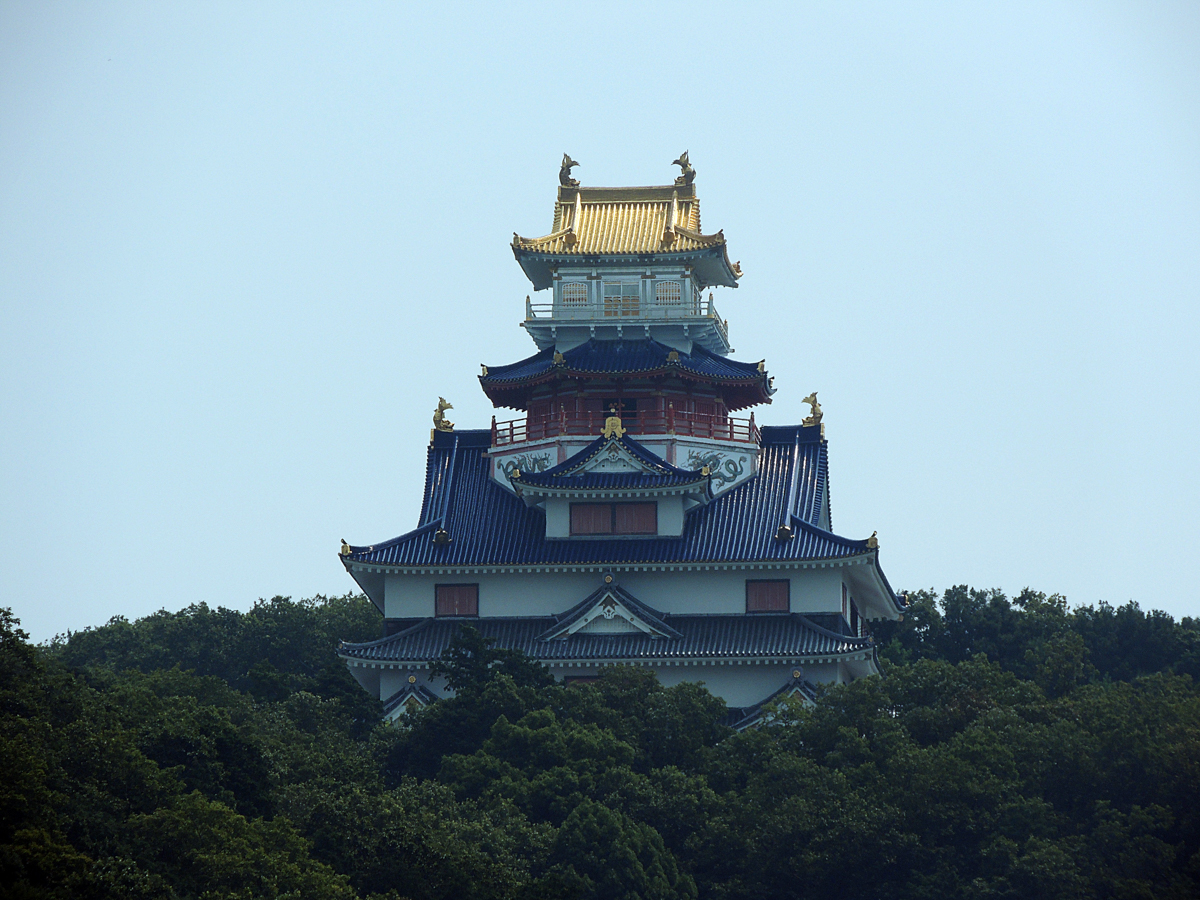
Continuing his expansion, Oda Nobunaga began to dislocate his generals in control of individual provinces. Shibata Katsuie and Maeda Toshiie were sent to the north and Akechi Mitsuhide to the Tamba province. Hashiba Hideyoshi was instead sent to the West in 1577 against the Mori clan. The latter was sustaining with supplies by sea the Ikko fortress of Ishiyama Honganji. Here Nobunaga's army ran the siege for some time from the ground.
In 1578, the new Nobunaga's castle was completed, known as the castle of Azuchi. Impressive for its extravagant decorations, the period between the fall of the Ashikaga shogunate and the death of Nobunaga was named from this castle. This is now known as Azuchi period.
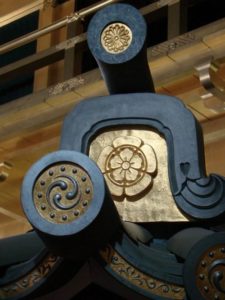
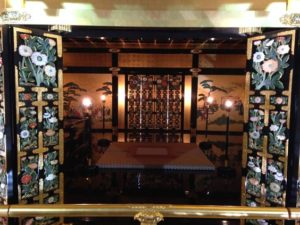
Oda Nobunaga & Uesugi Kenshin
In 1577, however, Uesugi Kenshin, the second best general of his time after Takeda Shingen, decided to take part in a second anti-Nobunaga alliance. The first encounter took place at the Battle of Tedorigawa, resulting in a decisive victory for Kenshin. Uesugi then began to prepare his march on Kyoto. According to one tradition, Nobunaga allegedly confessed to one of his officers that if Kenshin had come to Kyoto with his army, he would have no choice but to surrender and hope to be spared. Uesugi Kenshin, however, died, possibly of a heart attack, or perhaps stomach cancer, while he was in his wash house. According to sources of the time, his health seemed compromised since some time.
Without no good rivals, Nobunaga forced the last Ikko rebels to surrender in the fortress of Ishiyama Honganji in 1580. This completely destroyed the Takeda clan in 1582, during the Battle of Temmokuzan.
Nobunaga was now the undisputed authority in the country, and was preparing to move his armies against the provinces of Echigo, and Shikoku.
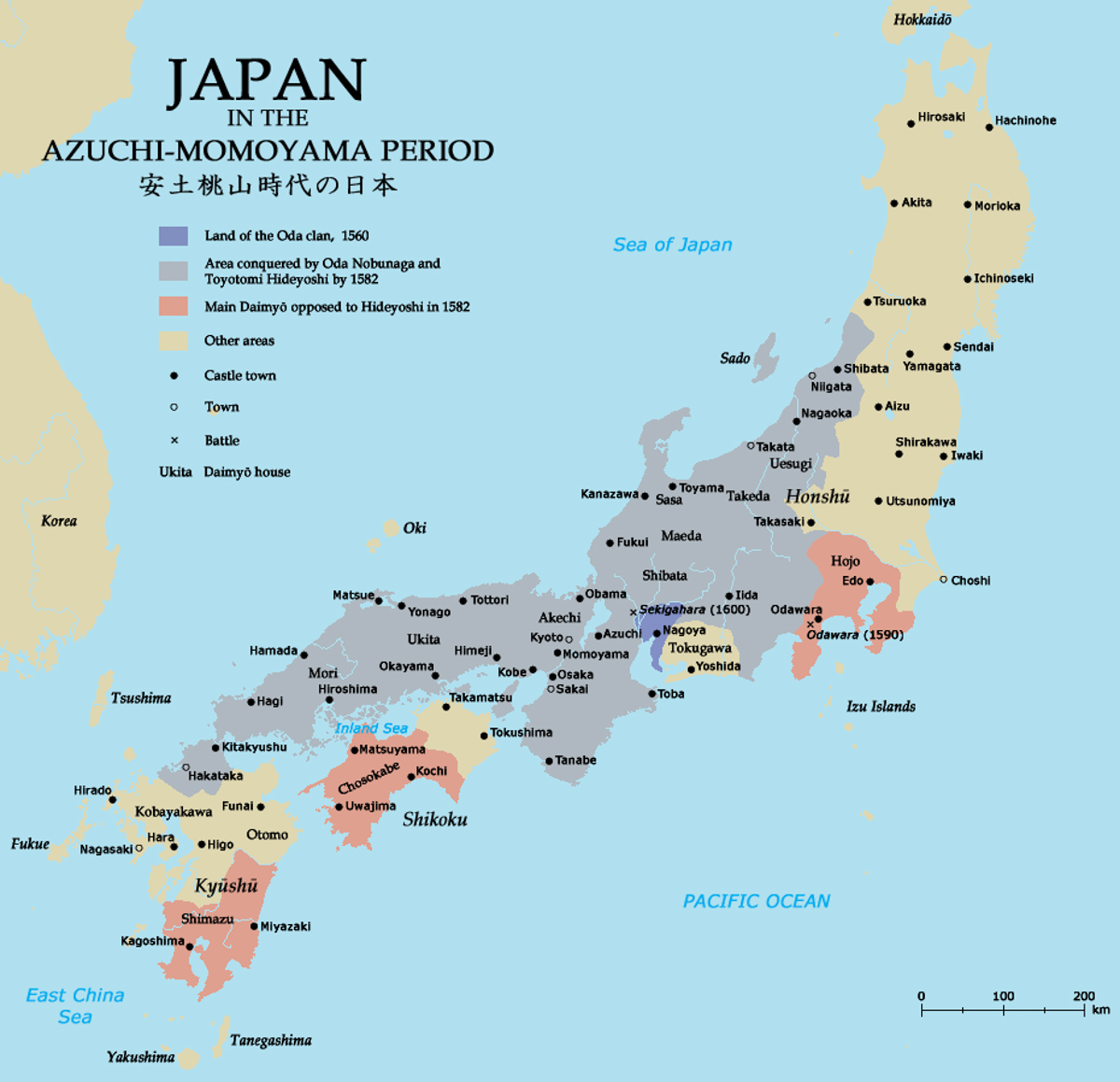
Japan in 1582. The purple areas indicate the territories controlled by Oda Nobunaga in 1560, and the gray areas indicate the territories controlled by Oda Nobunaga until his death, in 1582.
From 1582
In 1582, Hashiba Hideyoshi, one of the generals closest to Nobunaga, invaded the province of Bitchu, besieging the castle Takamatsu. The latter was vital to the Mori clan, because it occupied a strategic position from which it was easy to penetrate into their domain. Mori Terumoto arrived with his army in support of Takamatsu Castle. The two sides found themselves in a stalemate. At this point, Hideyoshi asked reinforcements to Nobunaga.
It was noted that Hideyoshi didn't really need reinforcements. However, he still asked the help of his Lord. According to some, he did it not to directly take credit for the victory, because many generals do not take kindly to the success of a general of humble origin and not part of a samurai clan. According to others, Hideyoshi intended to put Nobunaga in a critical position so to be able to take a personal advantage.
In any case, Nobunaga left the preparations for the invasion of Shikoku to Niwa Nagahide and went with Akechi Mitsuhide to reach Hideyoshi. Along the way, Nobunaga and his men paused in Honnō-ji temple in Kyoto. Here Nobunaga, being at the center of his rule and considering himself safe, was guarded only from a few trusted servants and guards. Unexpectedly, Mitsuhide Akechi ordered his men around the temple in an attempted coup. In the skirmish that followed, Nobunaga lost and retreated inside the temple and Mitsuhide, applying the technique that Nobunaga had so often used, set fire to the temple.
Oda Nobunaga and the legend of his death
It is not known what happened to Nobunaga in his last hours of life. Probably he and his attendant Mori Ranmaru accomplished seppuku while the temple was burning. His remains were never found in the rubble of the temple, giving rise to a wide range of popular legends.
Immediately after the coup, Mitsuhide's men attacked the Nijo Castle, where they forced Nobunaga's heir, Nobutada, to perform seppuku in return.
For eleven days Mitsuhide met various members of the Oda clan and the imperial court to be appointed successor of Nobunaga invain. Upon receiving the news, Hideyoshi signed a truce with the Mori clan. Then he reached out and killed Mitsuhide at the Battle of Yamazaki after only 11 days from Nobunaga's death
Oda Nobunaga, the head of the clan
Nobunaga never accepted any of the titles that were offered. He remained only the head of the clan Oda and the daimyo of Owari. Nevertheless, his authority allowed him to introduce major changes in the country.
One of the most important news of the Azuchi-Momoyama period was the creation of samurai families. In the Muromachi period in fact the many wars had led the clans to accept in their armies anyone skilled in combat. During the Sengoku era basically every male Japanese adult belonged to at least one military organisation.
From 1576 Nobunaga began to confiscate weapons to peasants in the territories he controlled. In this way he reduced the risk of riots and the number of fighters from him not directly controllable. His successor Toyotomi Hideyoshi, despite being originally from a family of farmers, completed the work. He recognized by law the samurai caste. Access to this caste could thus take place only by inheritance by banning all non-samurai to carry firearms. Samurai families who had opposed Nobunaga first, and then Hideyoshi and Ieyasu, were declared illegitimate. Their components became rōnin or civilians.
Oda Nobunaga's military plan
On the military level, Nobunaga led his army to the technological level of the European ones. He took the first large-scale spears, firearms, armored ships, and fortifications worth of the period of mass wars. Some sources also attribute to him the creation of the multi-line formation of the troops equipped with muskets. In this way he was able to ensure continuous focus and therefore a greater impact on the enemy. This tactic, used for the first time in 1575 during the Battle of Nagashino, would in fact appeared in Europe only in 1590. Nobunaga made the first extensive use of European weapons for its military campaign. He brought a radical change to the antiquated military tactics employed by Japanese armies.
His wars, however, are remembered primarily for their violence and ruthlessness. To this we can add the practice of burning enemies alive, that Nobunaga used as a warning to his opponents.
Oda Nobunaga focused on the specialization and professionalization of his army. He gave assignments and promotions based strictly on merit, almost completely ignoring the rules of nobility and family relationships. The rise of Hideyoshi is a prime example of this.
The defeated daimyō expropriated lands then redistributed them among his vassals not based on size, but on the production of rice. With some modifications, Oda Nobunaga's organizational system was extended to the entire country with the beginning of the Tokugawa shogunate.
Oda Nobunaga's economic plan
Economically, Oda Nobunaga showed great competence, building castles as focal pin for the economy. In this way he favored the migration from an agricultural economy to a manufacturing type. He built roads between the castles, to facilitate commercial traffic and the movement of armies. He conformed the units. He enhanced the international traffic, with China and Korea also with Nanban ("southern barbarians", a term that covers the Philippines, Siam, and Indonesia, but also Europe). Moreover, he established the Rakuichi Rakuza, to encourage the opening of unions, associations and guilds, prohibiting monopolies that Nobunaga considered an impediment to trade and he also developed laws requiring cases of tax exemption and regulated the contraction of debts.
Oda Nobunaga and the art
Thanks to the wealth accumulated over time, Oda Nobunaga financed various forms of art, and built beautiful gardens and castles. His castle of Azuchi on the shores of Lake Biwa is described by contemporaries as one of the best in history. Covered with gold and statues on the outside and decorated inside with screens, sliding doors, paintings on the walls and ceilings, especially by Kano Eitoku. In this period, Oda Nobunaga's master of ceremonies, Sen no Rikyu codified the rules of cha no yu, the tea ceremony. Nobunaga made this ceremony very popular and used it to discuss politics and business. Under his rule the first examples of kabuki also appeared, developing more organically in the more peaceful Edo period.
Oda Nobunaga and European Culture
Nobunaga was very interested in European culture, so much so that he collected works of art, arms and armor from the west of the world. It is considered one of the first Japanese to be wearing European clothes. Although not religious, he supported the Jesuit missionaries in Japan as a political move against Buddhist monks. Under his rule, on August 15 1576, it was built the first Christian church in Japan.
According to the sources Oda Nobunaga and the entire Oda clan were descendants of both Fujiwara and Taira clans. His ancestry can be directly traced back to his great-great-grandfather Oda Hisanaga, followed by Oda Toshisada, Nobusada Oda, Oda Nobuhide, and Nobunaga himself.
Oda Nobunaga today
Nobunaga appears frequently in the narrative and continues to be described in many anime, manga, video games and movies. It is generally described as evil nature or even demonic, although some of the works depict him in a more positive light. This type of work includes the films of Akira Kurosawa Kagemusha - The Shadow Warrior. Here the character of Nobunaga is energetic, athletic and respectful of his enemies. In Goemon he is described as a master of Ishikawa Goemon. Nobunaga is also a protagonist of the historical story Taiko Ki Eiji Yoshikawa, here is a firm but benevolent lord. It is described in a heroic manner even in some video games as Kessen III, Ninja Gaiden 2 and the Warriors Orochi series. In one of the Hunter × Hunter Ghost Brigade members is a samurai named Nobunaga Hazama.
Oda Nobunaga nelle serie TV e videogiochi
In contrast in the series of novels and anime Yōtōden, he is described literally as a demon and a lord of warhungry for conquest. In the novel The Samurai's Tale by Erik Christian Haugaard, he is an antagonist "known for his merciless cruelty." It is described as evil or megalomaniac in some manga and anime series including Samurai Deeper Kyo and Flame of Recca.
Nobunaga is described as evil, bloodthirsty, and / or demonic in many video games such as Ninja Master's, Sengoku, Inindo: Way of the Ninja and Atlantica Online, and the game series of Onimusha, Samurai Warriors, Sengoku Basara (and its adaptation as anime) and Soulcalibur. It is also mentioned in Detective Conan in an Osaka case (283-285 episode of the anime).
There are also numerous examples of his descriptions in a more neutral or historical context. These are found especially in the taiga drama (fictional series) on Japanese television. Oda Nobunaga also appears in the manga series Tail of the Moon, Kacchu no Senshi Gamu and in the historical novel by Tsuji Kunio The Lord Shogun of the Warring States. Historical representations in video games (mostly in Western strategic games) include Shogun: Total War, Total War: Shogun 2, Throne of Darkness, "dominations", Ninja Commando and the series Nobunaga's Ambition, like Civilization V and Age of Empires II: The Conquerors and Sengoku Basara.

Oda Nobunaga was also played by the Japanese singer and actor GACKT in live action Sengoku Basara -Moonlight Party- taken from the video game Sengoku Basara, which aired in 2012.
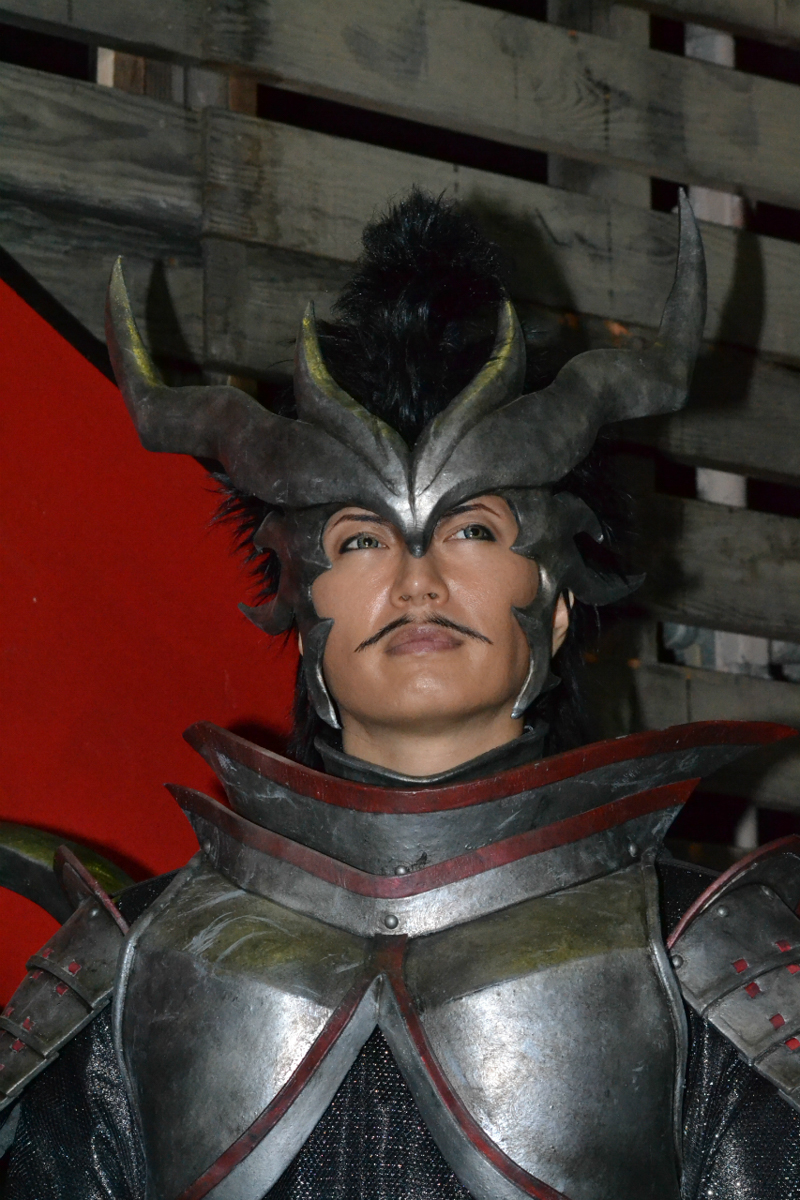
GACKT himself created the ending theme of the live action Sengoku Basara -Moonlight Party- with the song Hakuro, in which there are video images of him as Oda Nobunaga, here's a preview of the MV:
https://www.youtube.com/watch?v=-HmJ9urodNs












